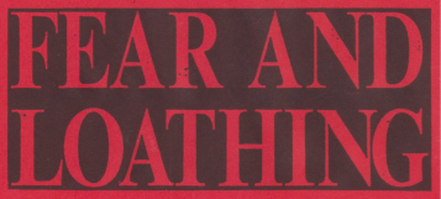BOOKS, fanzines and other good reads...

LOST IN ROOM. Mark Perry with Richard Johnson (Fourth Dimension) Aside from producing ‘Sniffin’Glue’ (the first UK punk fanzine) and as front-man for the band Alternative TV, Mark Perry has always been a great subject for interviews because he always seems to have interesting opinions about a broad range of subjects. You may not agree with everything he says, but he’ll always bring something new to the conversation. So it’s fitting that this book is made-up by a series of interviews rather than just having his life-details listed in the usual biographical format. Much like JJ Burnels’ recent book (see below) this allows the subject to open-up a lot more than just retelling their story and concentrating on the parts that they think people want to read about. This also isn’t a complete biography as it concentrates on the music that Mark was involved-with between 1978 and 1981, from the classic ATV album ‘The Image Has Cracked’, to the ensuing experimental albums released either as Alternative TV, the Good Missionaries, The Door and The Window, The Reflections, or simply as Mark Perry. Alongside details of the records themselves, Mark get to talk about the ideas and intent behind each of the projects, starting from when he first became interested in the early Punk scene and decided to get involved by starting ‘Sniffin’ Glue’ in 1976. It continued until August 1977, when he chose to concentrate on his own music. He was already becoming disillusioned by the way that the punk scene had allowed itself to be watered-down, most notably expressed on the ATV single ‘How Much Longer’, so when their debut album was released in 1978 it was no surprise that it featured a variety of styles and new ideas, providing the perfect bridge between ‘punk’ and so-called ‘post-punk’. Scene. It’s one of the true classics of the punk era, even though stylistically it was defiantly moving away from the genre. But this still wasn’t enough and, after playing on a ‘free’ tour with Here & Now, the next ATV album took things even further and explored even more radical possibilities. Commercially-speaking, ‘Vibing Up the Senile Man’ was a disaster, but it was also a very brave musical statement which has since been reappraised by many listeners and now receives much more credit than ever before. Over the next few years, Mark moved away from Alternative TV, first by adopting the name, ‘The Good Missionaries’ and then becoming involved with other bands (sometimes as a drummer.) A solo album presented more of his experimental ideas, but he then decided to confound listeners once again by reuniting with original ATV guitarist Alex Fergusson and producing the album ‘Strange Kicks’, which found them delving into New Wave, Ska and Pop, confusing fans and listeners once again! The realisation you’ll get from this book is that Mark and ATV have always pursued their ideas as and when they seemed appropriate and never because they might be what the audience was expecting. It’s as if ATV felt an obligation to challenge their audience as much as they challenged themselves. After all, Punk was never meant to be predictable so they focused on what they could do next. If you look at their discography, it’s clearly a principle that runs through all of their records and continues to this day. Alternative TV have never been as commercially successful or as critically acclaimed as some of their contemporaries because they’ve never made things easy, either for themselves or their audience, but by doing so they’ve produced a legacy that should never be ignored. Reading this book will give you further insight into the inspiration and reasoning behind a band that remain relevant and still have something worthwhile to say.

STRANGLER IN THE LIGHT. Jean Jacques Burnel with Anthony Boile. (Coursegood) Instead of a regular autobiography, this book sets out to relate the story of JJ Burnel in the form of a series of interviews, covering his life both inside and outside of the band. This has the advantage of addressing his story from the perspective of third party, discussing the events that they want to know about rather than the subject discussing events that he thinks are most relevant. This could be disastrous if the wrong people are involved, but Burnel and Boile obviously have a good, trusting relationship which allowed an open and in-depth dialogue, with plenty of balance to ensure that it never became too petty or obsessive. Once you start reading the book, you’ll realise that JJ is being very honest about events and achievements, whether positive or negative, but obviously these are opinions from his perspective. If you read Hugh Cornwells’ biography or other books about the Stranglers, you’ll find different opinions about the same events but that’s the way that memory and perspective work. JJ can only tell the story the way that he understands it and there’s bound to be parts of it that others will disagree-with. That’s okay, as long as you can accept it for what it is. That said, in this case, most if not all of the book rings true, particularly his childhood, his early years with the Stranglers and the decades following the departure of Hugh. He doesn’t hold back concerning his own diminishing interest in the band during the last few years with Hugh and later on, when the band expanded to a five-piece. I think most fans will agree with his assessment, that the band had lost their way and didn’t rediscover their focus until Baz Warne joined the band and they returned to the four-piece format. His enthusiasm and passion for the band, once he had a new creative-partner to work with, explains the renaissance they’ve achieved in recent years, enjoying as much if not more popularity now as they ever did in the Seventies of Eighties. Indeed, his working-relationship with Baz Warne is an essential part of the story, especially following the loss of Jet Black and Dave Greenfield. It’s that rediscovered enthusiasm which allows the band to continue with credibility, even though JJ is now the only original member. Of course, there are some things which don’t get answered, but in most ways this book will help to explain many of the questions that fans have wanted to ask. It’s not a definitive statement as, without Jet Black and Dave Greenfield’s input, that’s highly unlikely to ever appear. But as I said, read this alongside the other books already out there and you’ll get some idea of what it was and still is all about. This is a well written and thoughtful book, with plenty of entertaining anecdotes alongside the many facts and details. If you want to know all about the Stranglers, this is an essential volume.

NEFARIOUS ARTISTS by Welly Artcore (published by Earth Island) This is an interesting concept; an attempt to put the evolution of Punk Rock between 1976 and 1989 into context in terms of compilation and ‘sampler’ album releases. This was the way that record labels attempted to bring new music to the attention of listeners before the advent of the internet…. It’s a bit of a convoluted idea and does rely on subjective opinion to a great degree, but at the same time it makes a valid point - that the compilation album provided an important service for fans who may not have heard these bands otherwise. A while ago, someone much younger than me (most people are much younger than me) asked how I got to hear about new bands before the internet and I was able to say, ‘We had John Peel!’. No one can under-estimate his influence, although in many cases he would just point us in the right direction rather than telling us what we should hear, and leave the rest up to us. So many of these albums were (and still are) a gold-mine for fans, who would come across bands they may never had heard otherwise and discover obscure releases that would blow them away. It happened for me several time, the ‘Wargasm’ and ‘Yes LA’ albums being particular ear-openers. This book attempts to list all of the punk-related compilations during those years, from the incredibly important ‘The Roxy London WC2’ and the Maximum Rock’n’Roll- related ‘Not So Quiet on the Western Front’ through to the commercially-marketed (but surprisingly enjoyable) ‘We Do ‘em Our Way’ on the MFP label and the notoriously-misguided but sometimes great ‘Oi!’ series. It has to be said, this is a book for the fans, but once you get into it you’re going to find a lot of great information. You can’t say fairer than that!

THE RESURRECTION OF THE CRAZED by Paul Wainwright (published by Earth Island) The original Punk scene diversified very quickly, inspiring and kick-starting many different genres. Obviously the Two-tone/Ska movement was one such development, updating the original Ska sounds of the Sixties with a new attitude and energy, but at the same time there was a similar resurgence of interest in Rockabilly with new bands borrowing the snarling rage of Punk and creating Psychobilly. ‘The Crazed’ was the first and one of the only fanzines that covered this scene during its’ heyday in the early Eighties. Paul Wainwright produced his fanzine in the time-honoured DIY fashion, learning what to do as he went along. Bands, even those at the forefront of the scene, were still relatively easy to get in touch with and, over the course of four issues he managed to include interviews with groups that constituted a who’s-who list of the seminal Psychobilly bands; King Kurt, Demented Are Go, Guanabatz, Restless and, of course, The Meteors. Originally centred around the legendary Clarendon (aka Klub Foot) venue in West London, the Psychobilly scene quickly established itself and spread across Europe and America, ensuring that it would continue to thrive even to this day. In a bid to document the whole movement. Paul also included interviews with individuals who were playing important parts in the scene, such as the influential guitarist Boz Boorer and Roy Williams of the early Psychobilly record label, Nervous, adding further dimensions to the story. This book avoids merely recreating the fanzines page-for-page and instead tells the story of how Paul found his own identity in these new bands and their music, as well as explaining his reasons for creating the fanzine. The interviews feature many of the best-known bands, but also others who were short-lived or who were never destined to become widely popular. The original material is reset in a tidier, more accessible style and the book also includes rare photos, gig-flyers and other memorabilia. But the really nice addition here is the inclusion of new interviews with many of the people who were featured in the original fanzine, updating the story of their bands and sharing their thoughts on the scene four decades later. This is an important and entertaining overview of the original Psychobilly scene and, even if you weren’t a particular fan of that style, there’s plenty here to keep you intrigued and amused.

THIS IS MY EVERYTHING by Christan Spath (published by Earth Island) I often find books about lesser-known bands just as fascinating as those about the more successful ones, because their stories come from a more grass-roots level which I can really appreciate and relate to. This book is a prime example; written by Christian Spath, former guitarist/singer with the German hardcore band Tidal. I’d never even heard of them before receiving this book, but right from the outset I was hooked on his story, from his earliest interests in music through to the bands’ touring-adventures across Europe and even South America. They may have crossed paths with some pretty well-known bands along the way but everything they achieved was accomplished through their own efforts. Working on a DIY basis, they set-up their tours and recording sessions by themselves, networking with similar bands to discover new venues and potential audiences. Of course, they encountered just as many mishaps as successes but their dedication towards seeing how far they could take the band always kept them going. It’s that attitude and spirit that many of you will recognise, especially if you’ve ever been in a band, written a fanzine, promoted gigs or any other activity done because you believed in it rather than just doing it ‘for the money’. The book is written by Christian and reflects his perspective, so other people may remember things differently, but it does come across as a sincere and well-balanced tale. The band eventually split-up in 2005, so the final few chapters recount Christian’s later bands, bringing everything to a tidy conclusion, but more importantly the book serves as a testament to self-belief and reveals what can be achieved when you adopt the right attitude.

THREE AND A HALF MINUTES OF FAME by Alex Boucher (published by Earth Island) I was surprised when this book arrived. I had sorta-known Alex when he was playing drums in Travis Cut but never knew him well enough to know about all of his other escapades. The first revelation that this book presented was that he had previously been in a band called Three and a Half Minutes, a band that had been quite popular on the indie scene during the late Eighties/early Nineties. I’d even seen a couple of their gigs, although obviously I had no idea who Alex was at that time. After he left Travis Cut, I didn’t see him again and the second big revelation here explains it all… Alex joined a Boy-band! Yes, that’s right, all the details are here, although it still isn’t clear why he decided to switch from his indie/Punk roots to something so completely different. It’s almost surreal, but he makes no apologies and I can only assume that it was a rather epic case of thinking it was a good idea at the time. Either way, it does make for a pretty fascinating story and, as the saying goes, it’s better to regret something you have done than something you haven’t. Possibly even more bizarre is the episode when the attempted Boy-band comes to an end and he briefly rejoins Travis Cut, only to play a gig that ends-up in a mini-riot instigated by Neo-Nazi thugs, Combat 18! (Having been at that gig, I can also say that this is the first time I’ve seen an accurate written account of what happened.) The remaining chapters reveal what happened as Alex tried to continue playing music but , after suffering the loss of his best friend, eventually became disillusioned and moved away from his attempted-career. It’s a really good story and there are plenty of moments that any fan of ‘alternative’ music will appreciate and relate to, while there are also just as many that will leave you entirely bemused. But that’s the beauty of it, because not everyone is the same or follows a similar path. This is an intriguing and well-written story that will keep you turning the pages from start to end.
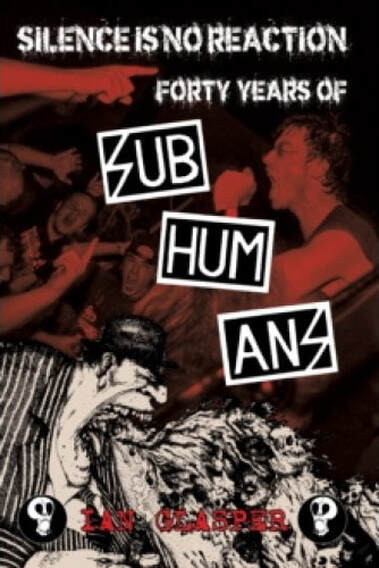
SILENCE IS NO REACTION by Ian Glasper (published by Earth Island/PM Press) Subtitled ‘Forty Years of Subhumans’, this book delivers exactly what it says on the cover. With more than 600 pages, this tome covers every aspect of the bands’ career in an extremely thorough fashion, from their origins in local bands like The Mental and Stupid Humans through to their current popularity around the world. They may not have reached the mainstream charts, but their records have always sold-well and their older releases, for the most part, remain in print to this day. Part of their appeal is that they never strictly fitted in to any particular punk rock genre and, even though they played alongside and shared many of the beliefs and ideas of the original Anarcho-punk bands, Subhumans created a more melodic style that had just as much in common with 77/78 punk rock. They also found a way to effectively articulate ‘political’ ideas whilst never being afraid to have a sense of humour to balance the light and dark They’ve always pushed themselves to create exciting, original music and vocalist Dick Lucas has maintained a knack for writing lyrics in a way that avoids the kind of slogans and references that often cause bands from the early 80’s to sound dated when you hear them now. Dick tends to write from a more personal viewpoint, which has kept most of his songs sounding fresh and relevant. All these elements make them a great choice for a biography and with Ian Glasper at the helm, they have the ideal person to do the job. If you’re not already familiar with his previous books (‘Burning Britain’, ‘The Day the Country Died’ etc) then you really should be. Over the past 20 years or so, Ian has been documenting various aspects of the UK punk scene, showing how it has evolved over the years and continues to thrive, despite so many muso-experts claiming that it was all over by the end of 1978. Ian always does his job right, tracking down the bands, documenting their achievements and recording their stories to put it all in a viable context. The Subhumans were always going to be worthy of more than just a few pages, so Ian has risen to the challenge and delivered this excellent book. Fans are going to love it, whilst even those who weren’t particularly interested in the Subhunabns will find plenty of great stories and reasons to positively re-evaluate their opinion of the band. They may have taken a few lengthy breaks along the way, but Subhumans continue to write new material and perform live with as much energy and vitality as they’ve always done. This book provides all the information you’ll need to fully appreciate a truly great band.

PANDAMONIUM! By Simon Williams (published by Nine Eight Books) I first met Simon Williams around 1990. As we were both avid gig-goers it was inevitable, really, and we’ve been crossing paths ever since. His taste in music has always leaned more towards the ‘Indie’ side of things so we certainly didn’t agree on every band, but there has always been enough common ground so that we would often find ourselves in the same small pubs and venues. The thing that always stood out was his obvious passion for the bands and music that he enjoyed, something that most of us can relate to even if we listen to different styles and sounds. This book covers his time as a fanzine-writer and NME journalist through to the creation of Fierce Panda records and his subsequent music-based exploits which continue to this day. Fierce Panda was an extension of his love for the music and, with his dedicated attendance of legendary (lost) venues like the Bull & Gate, The Falcon and The Laurel Tree, he found himself in a position to work with many bands that were destined to become successful, long before the major labels had even heard of them. However, this in turn would create its’ own problems. As Fierce Panda became a reliable source to find-out about interesting new bands, it also became a favourite poaching-ground for the bigger companies, who would suddenly appear with their chequebooks to tempt away any promising talents. In a lot of ways, it’s the frustration over the mercenary way in which the music industry operates that caused the most problems and although outwardly he and the label appeared to be successful, he was also under a lot of stress and pressure to find a way to keep Fierce Panda viable. Sadly, these circumstances eventually led to an almost tragic outcome, but I’m glad to say that he got through it and has been able to tell his tale in this book. I don’t know how many FNL readers will share Simons’ indie-infatuation, but there are plenty of details and emotions here that will be familiar to a lot of us and the way the story unfolds is very relatable. ‘Pandamonium’ is written in Simons’ usual, insistent style (the puns, the puns!) which is both highly entertaining and poignant. It’s a book that’s well-worth reading and, if you’ve been attending gigs around London during the past few decades, there’s a fair chance that you’ll recognise at least some of the characters, venues and bands.
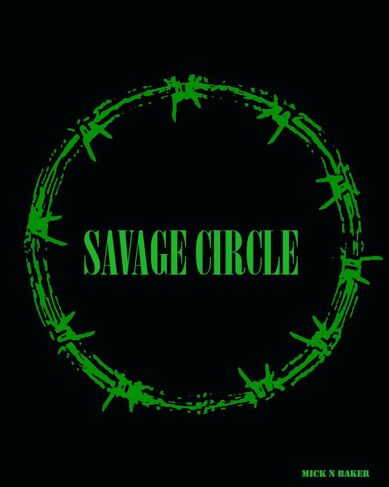
SAVAGE CIRCLE by Mick N Baker (contact -https://www.facebook.com/wh1teshrk/) I assume this is self-published, but you’ll be able to track it down easily on various internet sites. This is actually Mick’s fifth novel, following on from previous tomes referred to as ‘The Canterbury Tales’. I did wonder if it might be difficult to pick-up on this latest instalment without having read its’ predecessors, but it wasn’t a problem at all (although it definitely made me keen to read the other books.) The story is based in the Midlands during the early Eighties and follows the life and trials of Skinner, a young punk rocker who tries to buck the system with various petty scams, most of which having a tendency to fall apart rather quickly. There are plenty of references to the contemporary music scene, while Skinners’ attempts to get his own band up and running never materialise but end-up in a violent rivalry with another local band. However, Skinner isn’t an unlikeable character and you can’t help but hope that some of his schemes come to fruition. The problem is that he often instigates the events that cause him to fall, such as the loss of his long-suffering girlfriend Cerys, but never takes or understands his own responsibility. It’s a common burden of youth that many of us realise as we get older and also something which readers should be able to relate to. Elsewhere in the book there are plenty of intriguing and sometimes eccentric characters that tend to ring true and details from the era that will reawaken memories. The story ends with a bit of a cliff-hanger, suggesting that another book will continue the tale and, after reading this, I’m look forward to it. ‘Savage Circle’ is a highly entertaining book and even if you weren’t around during the era it covers, you should find plenty to enjoy.

KILLING JOKE – ON TRACK by Nic Ransome (published by Sonic Bond) Killing Joke have always been one of the more complex bands to have emerged from the Punk era. Musically, they sounded unlike anyone else, most probably because each original member brought-in their own individual influences. At the same time, their approach took their ideas and beliefs to a different level. Whilst many punk bands aligned themselves to anarchism, Killing Joke adopted a radical stance that questioned everything and refused to fall in line with any singular school of thought. Likewise, while many bands have dabbled with the ‘occult’ and esotericism (usually as nothing-more than a gimmick) you certainly got the impression that Killing Joke had a good idea of what they were talking about. Since those early days, the band has faced much turmoil (with only Jaz and Geordie as consistent members) and had its’ ups-and-downs. But mostly they have delivered music of the highest quality and their live performances have become the stuff of legends. This book, subtitled ‘every album, every song’, sets out to explore every record they’ve released to date and present the relevant details behind each track. Nic Ransome has been an avid fan almost from the inception of the band and certainly knows the subject well, But most importantly he knows how to maintain a balance between praising the bands’ high-lights (of which there are many) and merely becoming obsessive or sycophantic. His musical knowledge is such that he can explain in technical-terms how the band developed certain sounds, but never forgets the importance of the primal, gut-feelings that are such an integral part of Killing Joke. He also appreciates their sense of humour and the way they evoke ‘trickster’ elements to illustrate their ideas and conclusions. This is a book that delivers the kind of details that fans will want to know and, in line with the spirit of the band, does so in a way that will give you plenty of things to think about for yourself. This is possibly the best book in this series so far and, whether you’re new to the band or a long-term gatherer, it’s something that you really need to read.
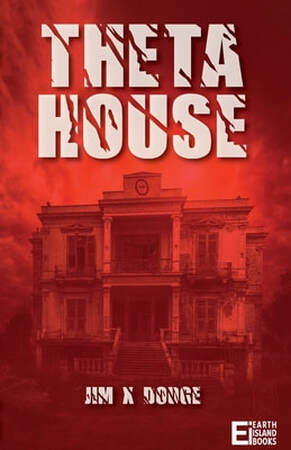
THETA HOUSE by Jim X Dodge (published by Earth Island) I was pretty intrigued by this book, a novella / horror story based on the ‘escape-room’ concept. In this particular tale, a group of ‘young adults’ from various contemporary subcultures / backgrounds are selected to take part in an overnight competition to solve the clues and escape from an old mansion, with a tempting cash prize ensuring that no-one turns down the offer. I was enjoying the story as the various twists and turns advanced, as well as seeing how the characters developed and revealed more about themselves and their motivations, but suddenly found myself with only a few pages left to go and, within those few pages, everything is brought to a abrupt and (for me) unsatisfying conclusion. That said, the ending certainly left plenty of scope for a follow-up or even an extended re-write of this story, but for now, the ending is a bit frustrating as it doesn’t do justice to the pace and tension that had been building-up in the preceding pages. Jim X Dodge obviously has a talent for story-telling and this book reveals a strong creativity. I will certainly be interested to see how his literary endeavours develop from here.
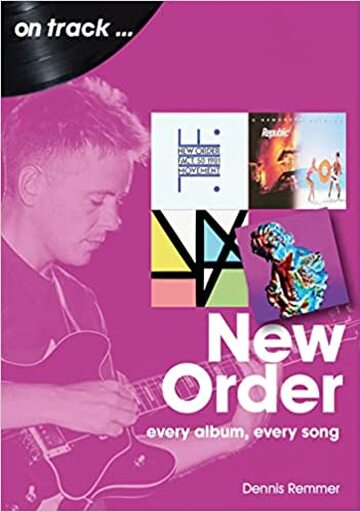
NEW ORDER – EVERY ALBUM, EVERY TRACK by Dennis Remmer (published by Sonic Bond) The great thing about this series of books is that the publishers allow the fans, rather than journalists, to write about their favourite bands. Of course, in some cases this could prove to be a disaster (such as an obsessive scribe refusing to consider the band and their music objectively) but so far Sonic Bond seem to have chosen their writers carefully. As a result, the books tend to be just what a fan would want, filled with the kind of analysis, anecdotes and trivia that we all enjoy! In this particular case, Dennis Remmer has managed to deliver a tome that thoroughly covers the history of New Order from their first tentative (but successful) steps after the tragic demise of Joy Division, through to the acrimonious departure of core-member Peter Hook and the bands’ eventual rise to the status of festival headliners around the world. He includes information (where available) about the evolution of songs from their early-demo beginnings through to their eventual release and (in many cases) subsequent remixes. He also provides details and stories about the band themselves, putting the recordings into perspective concerning the position they were in at the time of their recordings. But the important thing is that, although Remmer is clearly a mega-fan, he’s not averse to calling the shots when he considers that the band have released something that’s lack-lustre or not up to the standards that they’re capable of achieving. It’s this that creates an effective balance within the book and gives the reader good reason to trust his opinions. I have to say that I’m not a particular fan of New Order and I haven’t really paid much attention since the Eighties, but this book has certainly encouraged me to go back and check out some of the records that I’ve missed along the way. There’s no doubt that the band have been incredibly influential in their own right and having achieved that after the loss of Ian Curtis, it’s a remarkable story. This book gives you the nitty-gritty behind the songs which will help to show how they earned their success and continue to be such an important band.
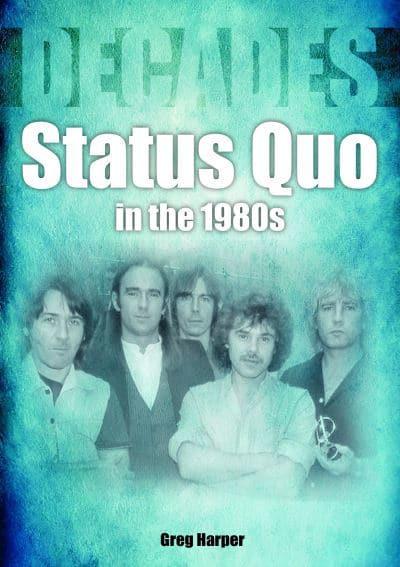
DECADES – STATUS QUO IN THE 1980’s by Greg Harper (published by Sonic Bond) Personally, I’m not a fan of Status Quo’s Eighties’ output but it was undeniably an interesting period of time in their history. Difficulties between the band members had been developing since the late Seventies, culminating with drummer John Coghlan leaving or being sacked from the band in 1981. The band then announced that they would stop touring in 1984, although their appearance at Live Aid in 1985 bought them to the attention of a much wider audience. Meanwhile, Francis Rossi and Rick Parfitt both attempted to record solo albums, but neither ended-up being released. Consequently, the band reconvened to start work on a new Status Quo LP but omitted their bass player and founding member, Alan Lancaster, who unsurprisingly took the matter to Court. Although this held-up the new line-up, they soon returned to touring and released the truly appalling ‘In The Army Now’ which, despite being as far away from their classic sound as they could possibly get, subsequently became one of their best-selling UK singles. Further successful records followed, but anyone hoping for a return to the bands’ powerful Seventies style was left disappointed (although their live shows were still mostly based around their Seventies material rather than the songs from the Eighties…) There are times in the narrative that it’s almost painful to read some of the decisions the band took during this decade, often compromising their style and direction for purely commercial reasons (particularly their attempts to appeal to the American market) but this book does go some way to explaining why they did those things. There were personal tragedies, managerial problems and various addictions that all helped to derail their progress, although they were still managing to release successful records on a pretty regular basis. I know there are fans out their who love this era of the bands’ career, so I’m sure this book, packed as it is with interviews and pictures, will appeal to them, but I’m also sure that out of curiosity it may well appeal to those of us who lost interest in the band during this time. So, if you want to know how it all went wrong or how it all went right, this is going to be a pretty definitive volume.
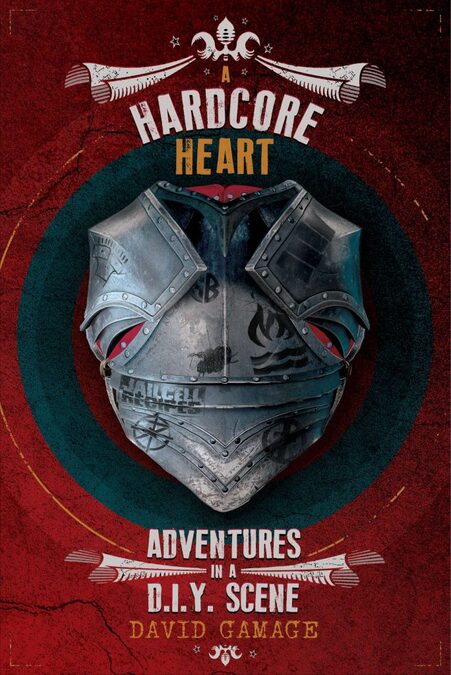
A HARDCORE HEART by David Gamage (published by Earth Island) Even as a paperback, this book is over 650 pages and weighs a ton! Since I do most of my reading on the journey to and from the day-job, it was a pain to be carrying it with me all the time, but that being said it turned out to be well-worth the effort. David Gamage, in case you don’t already know, has played guitar for several fine bands over the years and most recently has been playing with Come the Spring as well as continuing to run his own label, Engineer Records. But he’s also found time to write the story of his involvement in the punk rock world (‘Adventures in a D.I.Y. Scene’, as he calls it) and this tome is the result. Oddly enough, while he was putting together various projects in West Kent during the late Eighties, myself and a few friends were doing similar thing in East Kent so our paths inevitably crossed on occasions (and many of his tales about playing or attending gigs seem strangely familiar.)To some of us, even though we may have missed the early days of punk rock, the opportunities it had presented seemed to be a challenge… why not start a fanzine, organise a gig or even form a band of your own (as well as going to see as many other bands as you could...) Davids’ first band were melodic punkers the Couch Potatoes, who initially didn’t last too long (due to college commitments etc) before he helped to form Joeyfat, a band that mixed rock and post-punk influences and stirred-up quite a bit of interest in and around London. Following his unexpected exit from Joeyfat, he re-launched Couch Potatoes with a new line-up and, with more experience under their belts, went on to have a lot more success than their first incarnation, including record releases and European tours. When they came to an end, David would become part of a new band called Rydell, who again would have a distinctly different sound to what he had done before. By then, with plenty of contacts to hand and a better idea of how to achieve their goals, Rydell were able to play plenty of gigs, tour in Europe and release records, garnering plenty of support and good reviews along the way. Unfortunately, several unlucky events conspired to prevent them from going even further, but if you’ve ever been in a band you’ll know that’s the kind of thing that happens. In between all of this, there’s plenty of room for humour, excitement, frustration and satisfaction. David relates the stories in a down-to-earth, evenly-balanced way that, if you were ever involved in the DIY/indie/punk scene of those years, you are bound to recognise. There are several ‘big-names’ that appear in places, usually before they’d had much success, and there are less-invigorating tales about rehearsing in local farm-sheds, but it’s all an integral part of it. These are things that could have happened to any of us and, for me, stories like these are much more interesting than biographies of multi-millionaire rock stars who became famous playing safe, lowest common denominator pap. A book like this tells the story of people finding their own voice and doing something because they believe in it. Maybe the bands, labels and venues that David talks about aren’t household names, but they were real. So, find a copy of this book for yourself and indulge in the adventure.
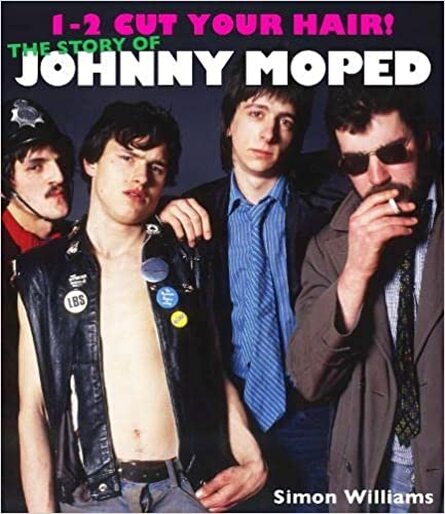
1-2 CUT YOUR HAIR – THE STORY OF JOHNNY MOPED by Simon Williams (published by Damaged Goods) The unlikely legend of Johnny Moped continues to grow! Not only did the band have a full-length documentary made about their original career, promptly followed by enthusiastic reactions to their recent recordings, but they now have a suitably entertaining biography available to recount their tale to date. Of all the original Punk Rock bands to emerge during the early days of The Roxy Club, the Mopeds were always one of the most eccentric set of outsiders to raise their heads above the turrets. While there were plenty of middle-class kids content to jump on the bandwagon, Johnny Moped were a band who were doing their thing because they couldn’t do it any other way. Their music was totally genuine and they were a bunch of misfits who, in mainstream-music terms, should never have even been allowed on a stage. But they got up and did it, regardless of what the audience might think, and along the way delivered some truly classic songs. They were never going to be liked by everyone, but those who ‘got it’ would forever be hooked. In this book, Simon Williams tries to get to the bottom of the many often contradictory stories behind the band, but instead of trying to pin-down the definitive ‘truth’, he leaves everything in place. This is important, as the many myths of Johnny Moped are just as entertaining and important as the facts that can be confirmed. Indeed, as thorough as this book is, there are still plenty of tales in circulation that didn’t reach the printed pages, but that just leaves more for you to delve into for yourself. As with the excellent documentary, this book manages to capture the spirit of the band and the characters that make it so unique. If you want technical-perfection, this is the wrong place to look, but if you want rock’n’roll as the real-deal, then your quest is over. Buy this book, enjoy the story and have a few laughs but never under-estimate the band, because their records and gigs are still more than capable of blowing you away!
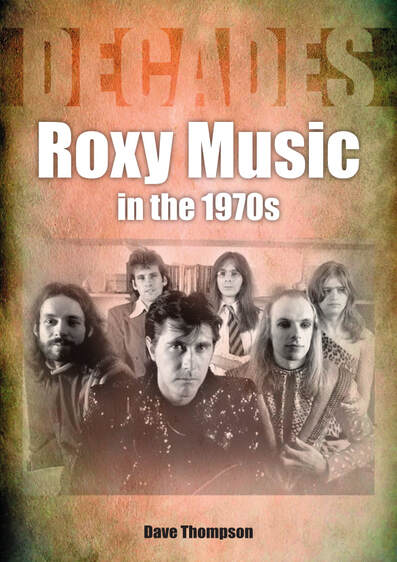
ROXY MUSIC IN THE 1970’S by Dave Thompson (published by Sonic Bond) For many years, I only knew Roxy Music from their hit singles, some of which were great and others pretty unremarkable. On top of this, I didn’t particularly like Bryan Ferry, who came across as a bit of a Tory pratt. However, once I got to hear the bands’ early albums, I was quickly won over. Their mixture of intelligent rock-music and Art-school leanings was a strong formula and the way they blended traditional elements with avant-grade ideas would prove to be highly influential over the subsequent decades. It is tempting to consider the first two Roxy Music albums, which featured original member Brian Eno, as their best, but the ensuing albums, ‘Stranded’ and ‘Country Life’, maintained high standards and it wouldn’t really be until the ‘Siren’ album in 1975 that their style really began to veer away from their original direction. That’s not to say that they weren’t still producing interesting music, but more that they were indulging in different styles. That said, from that point onwards it was more down to you personal taste as to whether you still enjoyed their new material. In this book, Dave Thompson covers each album (and, despite the title, also the records they produced after the Seventies) explaining how they came together and also providing details of the accompanying singles and their often-heavy touring schedules. On top of this, there’s also extensive coverage of the many solo albums and projects undertaken by the individual band members (including Eno, who has undoubtedly produced the most interesting ‘solo’ projects away from the band.) Again, how you consider the non-Roxy albums is going to be down to personal taste, but being aware of what the individuals did in their own time also helps to explain how things evolved as and when Roxy Music reassembled for the full-band projects. So, I can’t say that you’ll enjoy everything that Roxy Music have done (I certainly don’t) but their story is fascinating and this book will give you clear indications of what you need to seek-out for yourself.

NIMROD by Ryan Roberts (published by Earth Island) This is the debut novel from Ryan Roberts and it follows in the American ‘coming-of-age’ tradition, featuring teenagers trying to come to terms with their place in the world. Think of the books of S E Hinton, or even ‘Catcher in the Rye’… But where this story varies is that the main character, Rod, is part of a dysfunctional family due to the death of his older brother, an event that actually happened before he was even born. Due to the turmoil that the loss inflicted on his parents, his mother is now semi-reclusive and obsessive about her sons’ whereabouts and activities, whilst his father has submerged himself in his job. Rod himself has developed his own social quirks to deal with his surroundings, including an unlikely obsession with the singer Sting! But things start to change when he meets a girl, Cat, who is dealing with her own parental-difficulties. They bond over their similar problems and eventually form a relationship that will see them both find a way to take things forward. The story takes many twists and turns, sometimes funny, sometimes sad, but always with a strong sense of purpose. The couple have to find their own way through the pitfalls of ‘young-love’ and to a great degree they succeed, but never in an entirely orderly fashion. There are some details that I find a little out of kilter, but it’s a long time since I was a teenager, so what do I know? At the end of the day, it’s a genuinely entertaining novel with a believable depth to the characters and valid observations about the nature of friendship, trust and determination. It’s a great book and I totally recommend it.
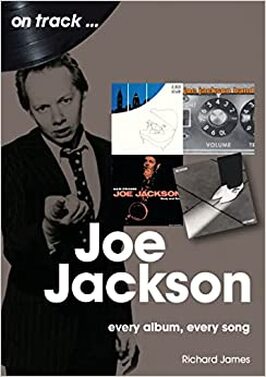
JOE JACKSON – EVERY ALBUM, EVERY SONG by Richard James (published by Sonic Bond) My own knowledge of Joe Jackson only goes as far as his early singles (‘I’m the Man’, ‘Is She Really Going Out With Him’, ‘It’s Different for Girls’ and then, a little later on, ‘Steppin’ Out’.) Although quite distinct from New Wave or Two Tone, somehow his music fit-in with the more adventurous spirit of the late-Seventies / early Eighties, combining well-crafted melodies with witty and often poignant lyrics that really stood-up for themselves. Joe Jackson himself was hardly a usual pop-star figure, but with songs as strong as these his chart success was not a surprise. Further on from that time, I’m aware that his career has continued with varying degrees of success on both sides of the Atlantic, but I can’t say that I’ve followed his various projects. So it’s rather surprising to discover just how many albums he’s released over the last four decades, and the variety of styles that he has embraced. Many original fans were surprised when he switched from his initial style over to the more jazz /jive influenced sounds of the ‘Jumpin’ Jive’ album, but since then he’s delved into even more diverse genres, including movie soundtracks and symphonies! The chances are that you’ve come across at least some of his music at one time or another and if you’ve enjoyed it, then this book will serve as the perfect guide to whatever you may have missed. I’m not saying that this is a book that will make you a fanatical follower, but you may well discover something new that you’ll want to investigate further.

WORST. EUROVISION. EVER. By Roy D. Hacksaw (published by Earth Island) A novel about imagined Eurovision Song Contest Finals taking place in Moldova, written by a veteran punk rocker, is an unlikely scenario in itself and I really wasn’t sure what to expect. But any doubts that I may have had were forgotten pretty quickly as the plot became more and more complex and the list of characters continued to grow. I can’t say that I’ve ever been a Eurovision fan, but it certainly provided a great backdrop for the shenanigans within this novel. A new director has been put in charge of the Contest following rumours of corruption and now has to deal with the event taking place in a new location, with all the problems and misinterpretations that this entails. At the same time, the elderly but much-loved singer who has been chosen to represent Moldova itself has forged an unexpected friendship with his runner-up, a much younger and not particularly talented Gothic-rock vocalist. The older singer has health problems and has named his protégée as his replacement in the increasingly possible situation that he is to ill to attend the final. Add to this, the day-to-day rivalries between the performers (including Norwegian Black Metallers, an Icelandic performer who sings and dresses as a dog and an Eastern European female vocalist with a temper akin to a tornado) plus rogue reporters who have no qualms in publishing entirely false allegations about the contestants. It may still seem like a plot that wouldn’t usually interest you, but once you start reading, you well may find yourself engrossed in the story and increasingly keen to discover what happens next. I have to admit that, at nearly 500 pages, it is perhaps a little longer than it needs to be, but it does have a good sense of humour and doesn’t drag its’ feet. Roy is obviously a fan of the whole Eurovision spectacle and keeps your interest all the way through the tale. While I doubt this novel will convert all of its’ readers into avid fans, it will at least give you a different perspective alongside a great yarn!
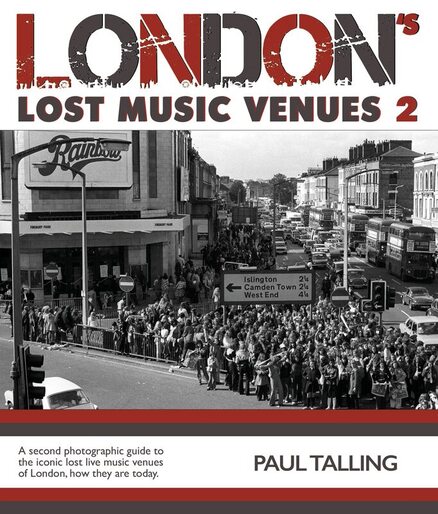
LONDON’S LOST MUSIC VENUES 2 by Paul Talling (published by Damaged Goods) The first volume of this project certainly stirred-up a lot of interest in the lost history of sites that played an important part in musical culture, not only in London and the UK but even on a worldwide basis. But one book was never going to be able to cover everything, so Paul Talling has completed a second volume to include venues that he previously had to miss, plus others that have since become victim to myopic ‘development’ and corporate greed. He’s done a very good job in tracking down so many venues and telling their stories in an informative but not too over-detailed fashion, which makes this a very-entertaining book even if the overall subject is quite sad in many ways. If you were ever a regular gig-goer in and around London during the last fifty years or so, I’m sure you’ll have fond-memories of particular venues that have since disappeared, but, just like the music and the bands themselves, things have to change and that’s inevitable. The thing that’s most riling is when iconic and clearly-historic locations are destroyed with no regard for their cultural importance. The Marquee on Wardour Street is a particularly good example, but you could also include places like Hammersmith Palais and even the Four Aces club in Dalston… places that were key to their communities and their culture. Perhaps one day, future developers will try to rebuild replicas of these places for tourists to visit, as happened with the Cavern Club in Liverpool, long after the original had been demolished. In the meantime, we’re fortunate that Paul has done such a good job in compiling all of this information so that the story of these places doesn’t become lost as the years move on. If you read the first book, I’m sure you’ll be keen to read this one. If you’re not already familiar with either volume, you really need to check them out soon.
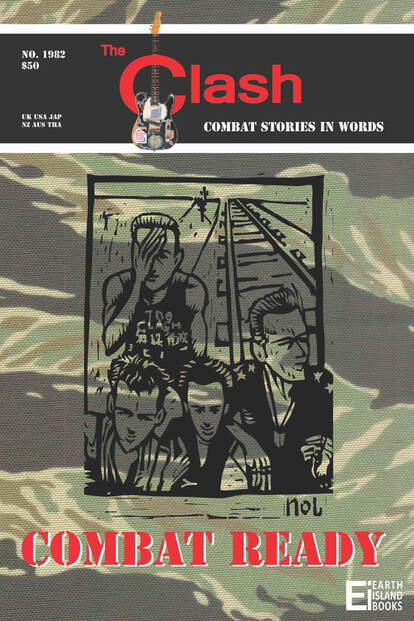
COMBAT READY by Tim Satchwell (published by Earth Island) New books about The Clash seem to get published on a pretty regular basis, so it’s easy to become cynical and end-up thinking, well, how many times do we need to read the same story? However, it’s also true that so many myths and versions continue to circulate about the band that it’s become difficult to find a definitive account of what they actually achieved. This book tackles a particular point in their career – the ‘Combat Rock’ album – and attempts to give the details of how and why it was released in the way it was. Although it ended-up being the bands’ most commercially-successful album, it was also the record that drew most criticism from existing fans and which lit the fuse towards the bands’ ultimate demise. Its’ predecessor ‘Sandinista’, despite containing some great tracks, had been an overblown triple LP and originally ‘Combat Rock’ had been planned as a double LP, produced by Mick Jones and entitled ‘Rat Patrol from Fort Bragg’. But tensions within the band (probably exasperated by the return of their original manager, Bernie Rhodes) and demands from their record label resulted in the recordings being pared down to a single album and remixed in a cleaner, less adventurous style by producer Glyn Johns. Around the same time, Topper Headon was struggling with a heroin habit and was eventually fired, creating further friction within the band. Their original drummer Terry Chimes came back temporarily to allow them to fulfil their tour-schedule, but despite the success of the album, the tensions continued and eventually led to the sacking of Mick Jones, a decision from which the band never recovered. Of course, there are many stories intertwined with these events and a lot of different interpretations of what really happened, but where this book plays smart is that, instead of trying to say exactly what happened, it tries to take into account all of the different versions, from the band members themselves, their management and others involved. And there are lots of different versions… sometimes you’ll find that every member of the band had a different view of what happened, so you have to make up your own mind about what seems most likely. Certainly, it puts the album in a completely different context and helps to explain why the album came out the way it did, as well as how it initiated events that tore the band apart. Whether you’re a fan of ‘Combat Rock’ or not, this book helps to clarify the situation that The Clash were in during that time and why, when they were on the verge of achieving the success that they had worked so hard to attain, they instead fell apart. As I said before, there are already enough books about the Clash that simply retell the same story, but this one takes things further to give you a chance to see what was really going on and why ‘Combat Rock’ turned out to be the beginning of the end.
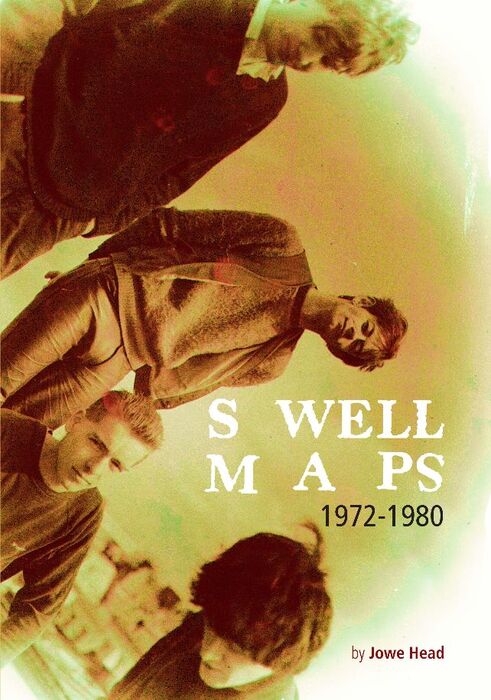
SWELL MAPS 1972-1980 by Jowe Head (published by Sounds on Paper) For a long time, the only books published about the ‘punk era’ were about the big names, predominantly the Pistols, the Clash and maybe The Jam. But while that’s all well and good, Punk was never just about the bands who achieved commercial success. Many of the truly influential and inspirational bands never had that kind of success or wider popularity, but have since gone on to be recognised by fans and other artists for the unique contributions that they made. One such band is Swell Maps, who are still not widely known but who did make a bunch of excellent singles and two great albums which have pretty-much remained in print ever since. Sadly, original members Nikki Sudden and Epic Soundtracks (two of the greatest punk monikers) are no longer with us, but original bass player / songwriter Jowe Head , although remaining highly active as both a musician and an artist, somehow managed to find the time to author this fine book about the band, detailing their origins in the early Seventies through to their demise in 1980. Originally starting as an elaborate amateur project under different names and line-ups, the artists-eventually-known-as-Swell-Maps eventually encountered Punk Rock and saw the possibilities that it presented… they didn’t have to be virtuoso’s to play live and they didn’t have to sign to a major label to release records. Alongside similar souls such as Desperate Bicycles and TV Personalities, they formed their own label and followed their own path. They brought a wide range of influences together to make music that didn’t sound like anyone else, and that still holds true to today. If you’ve never heard them before, you need to do so. Now! What this book relates is that, although they created some truly exceptional music, the individual members of the band weren’t from any kind of fortunate or exclusive background, they were just young kids who loved music and wanted to do something of their own. Many of the stories shared here seem familiar, because they were things that could have happened to any of us… Silly pranks, in-jokes, accidents, arguments, ideas that seemed great at the time… we’ve all been there! It is tempting to wonder what Swell Maps may have accomplished had they stayed together longer, but at the same time that could be said of many bands and, well, maybe the music they did make during that relatively short time was so remarkable that perhaps it’s perfect that they ended when they did? We’ll never really know, but at least this book may give you some clues. Additionally… whilst writing the book, Jowe came across some long-lost, previously-unreleased demo-recordings, so it just seemed right to include them as a bonus EP . Including early versions of ‘Harmony in Your Bathroom’ and ‘Cake Shop Girl’ (aka ‘Double Dose’) as well as several tracks that haven’t been available before now, this is the ideal accompaniment to the story. As such, you really need to consider this an essential purchase. Trust me, this is something you need to have in your home.
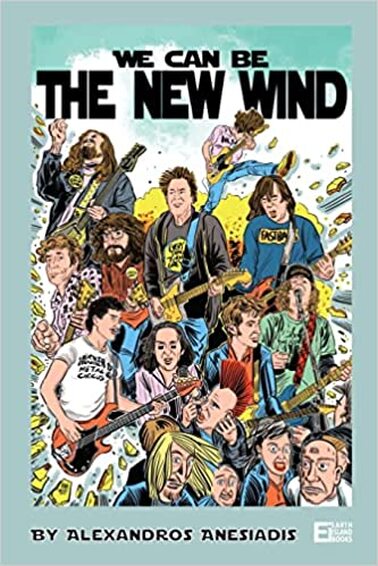
WE CAN BE THE NEW WIND by Alexandros Anesiadis (published by Earth Island) At more than 800 pages in length, this is a bit of an epic tome and attempts to cover a huge amount of bands and their record releases from (roughly-speaking) the early Eighties through to the early Nineties. I say roughly because some bands clearly existed before then and many continued afterwards, but their inclusion still works out. The premise is that, just as much as hardcore crossed over with metal from the mid-Eighties onwards, just as many bands mixed their hardcore roots with more melodic styles to create sounds that were more accessible and which, in time, would also pave the way for the wider success of indie, alt-rock, grunge and pop-punk. Now, whilst I can see that many of the bands included here were certainly a major influence on many of the later bands who became highly successful, I’m not so sure that such a disparate selection of musical styles can really be grouped together as a ‘scene’. The Hardcore/metal crossover scene was more easily defined because the common roots of those bands could, for the most part, be seen quite clearly. But I don’t think bands as different as Dag Nasty, X, The Fastbacks, Soul Asylum or Savage Republic really shared enough in common to be treated as a specific scene or movement (much that they were / are all great bands!) However, the one thing I can say is that this book covers a large period of my life in which many of these bands provided the ongoing soundtrack. There are so many bands here that I either saw, or bought their records, and sometimes even interviewed, so it all reads as pretty familiar territory… I even recall the names of the many bands that were recommended at the time but I never got the chance to check-out! To this extent, this is an invaluable book as it covers so many great or interesting bands that wouldn’t normally be given the credit they deserve because they didn’t fit-in with any well-defined genre. It’s pretty remarkable that author Alexandros has gone to so much effort to track down and interview so many bands and musicians, so his dedication cannot be doubted. Although mostly based around American bands, he has also tried to cover other areas (Canada, UK, Europe, Australia, New Zealand) so this is just about as thorough as it would be possible to compile. From a grammatical point of view, the text would probably have benefited from better editing, but that’s not such a big problem. What this book gives you is a solid volume that documents bands that all played a part in the music of their times and, in many cases, remain valid to this day. Get yourself a copy and see how much you still need to investigate.
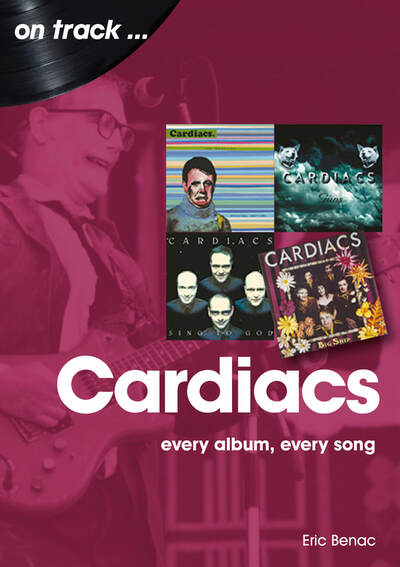
ON TRACK … CARDIACS by Eric Benac (published by Sonic Bond) The Cardiacs are a wholly-appropriate subject for the ‘every album, every song’ treatment, having released many albums over the course of their career, as well as much myth and confusion to bewilder anyone who may wish to delve into their musical legacy. The Cardiacs were never prepared to stand still long enough for listeners to catch-up with what they were doing and so, particularly in their earlier days, you almost had to rely on intuition to assess what they were presenting. In many ways this was perfect for a genuinely creative band, although from a business-perspective, it made things a lot more difficult. However, in the spirit of genuine English-eccentricity, it added to their charm and bolstered the intrigue and interest in the band, particularly in the years following frontman Tim Smiths’ ill-health and eventual death, which effectively ended the band in truly tragic circumstances. But there is still much to discover whether you come at it from a ‘prog rock’ perspective, or from punk rock, or even pop (albeit a rather demented vision of Pop.) I saw Cardiacs live a few times during the Eighties and no two gigs were alike. They reminded me of The Cravats and certain aspects of Punishment of Luxury, which was a great thing as far as I was concerned, although I’m sure other people would’ve made completely different comparisons. The thing is, you couldn’t pin them down 40 years ago and it’s still not going to happen now. But that being said, author Eric Benac does a very good job of walking you through the numerous releases (albums and singles) discussing their strengths and failures and pointing you towards the releases that may appeal to you the most. With a band like the Cardiacs, there’s never going to be one definitive album that captures their essence because they were continually redefining themselves. If you’re only just getting into them now, that’s going to make things difficult but this book is an excellent resource and will help you find an appropriate starting point. From there-on, it’ll be up to you how far you take your interests, but rest assured, there’s a lot to explore and enjoy.
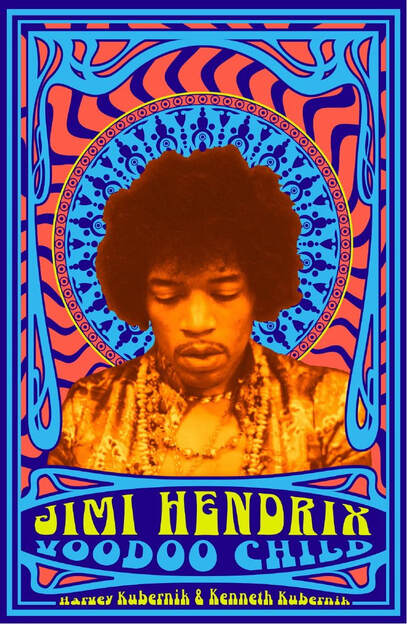
JIMI HENDRIX - VOODOO CHILD by Harvey Kubernik and Kenneth Kubernik (published by Sterling.) There are already over 300 books published about Jimi Hendrix. I’ve read a few which gave me the the facts, so to speak, but this new title takes a different approach and in doing so, makes the whole tale so much more real. It’s an ‘oral history’ of the Hendrix phenomenon rather than just another appreciation or documentary and, instead of being the work of a journalist about an artist he may never have seen or met, this book concentrates on the people who were there at the time and the impressions that Hendrix left in his wake. This book is all about the real Jimi Hendrix ‘experience’ (the effect not the band) and the incredible impact that he still has, even fifty years after his untimely death. This is, by far, the best book I have read about Hendrix. It’s the most enjoyable, the most convincing and the most informative, because it tells the story from the grass roots. Again and again, fans, friends and fellow musicians tell us of how Hendrix was such a likeable, humble and down to earth guy, and yet when he took to the stage, his talent was immense, challenging boundaries that had yet to be imagined. Other guitarists (Clapton, Page) had defined how far the instrument could go at that time, but Hendrix was more interested in what came next. There’s an almost-innocence, yet true intent to the way he unleashed the potential of noise and corralled it to his command. In some ways, it’s more difficult now to appreciate how much Hendrix achieved in such a short space of time but a book like this puts it in a better perspective. Think of it this way; he was working as a regular session musician up until 1966, before moving to London and forming the Jimi Hendrix Experience. In the ensuing four years, he released three sonically ground-breaking albums with the Experience, headlined at Woodstock, was banned by the BBC (always a mark of credibility), formed the ‘Band of Gypsy’s’ and released a live album, and eventually recorded ‘The Cry of Love’ LP before his untimely and unexpected death in 1970. In less than four years, he had changed the musical landscape and made an artistic statement that remains valid to this day. And all this from a black guy playing in a white guys’ world! In so many ways, this should never have happened, but in so many other ways, it was perfect. If you want to know what Hendrix really meant, read this book. The fans, friends and colleagues tell the true story. Perhaps there’s yet more that you can learn about Jimi Hendrix, but for now, this book will tell you what really matters.
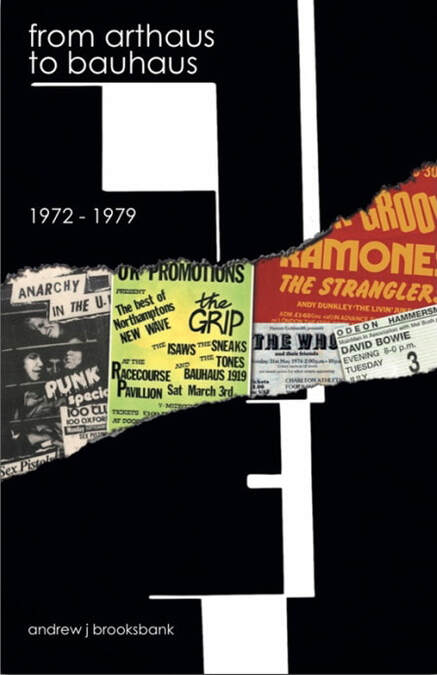
FROM ARTHAUS TO BAUHAUS 1972-1979 by Andrew J Brooksbank (published by Tome & Metre.) There are already several books on the subject of Bauhaus, including the excellent ‘Who Killed Mister Moonlight’ by bass player David J, but this new volume adds a different dimension by concentrating not on their success but on the years leading up to the bands’ formation and the eventual release of their classic debut, ‘Bela Lugosi’s Dead’. The author (who was also responsible for the much sought-after ‘Beneath the Mask’) has gathered stories from numerous friends and musicians who played a part along the way towards what would eventually become Bauhaus. Some of the memories may be a little confused or muddled at times, but what emerges is a tale that anyone who ever tried to be part of a band will find familiar. Some of the stories are inspiring, some are frustrating and others are hilarious. But what they capture are the sort of events that any budding musician has to go through, before during and after being part of a band. Things seem to be going well, only to fall apart, while other things seem to be going nowhere but later become a crucial part of later successes. Fortunately, Andrew Brooksbank became not only a Bauhaus fan early in their career but also a friend of the band members, giving him access to their archives and reminiscences, as well as personal insight into what eventually transpired. With input from Daniel Ash, David J and Kevin Haskins, he has tracked down old friends and band-mates from their early days in Northampton, and explains how their tastes and talents developed from the early Seventies through to the release of the single in 1979. Some of it might seem unlikely (playing dodgy covers in a band called ‘Jam’) whilst other moments make perfect sense (going to see Bowie at Hammersmith or the Sex Pistols at the 100 Club.) This tells how Bauhaus eventually came together and how their mutual and individual influences and experiences resulted in the seminal band that they became. The final pages of the book skip through their subsequent history, leading up to their split in 1983, various solo and collaborative projects and their eventual (and possibly ongoing) reunions, but you probably know these details already. The important stuff is the early days, and this book provides the details in a fascinating and entertaining fashion. Very recommended!
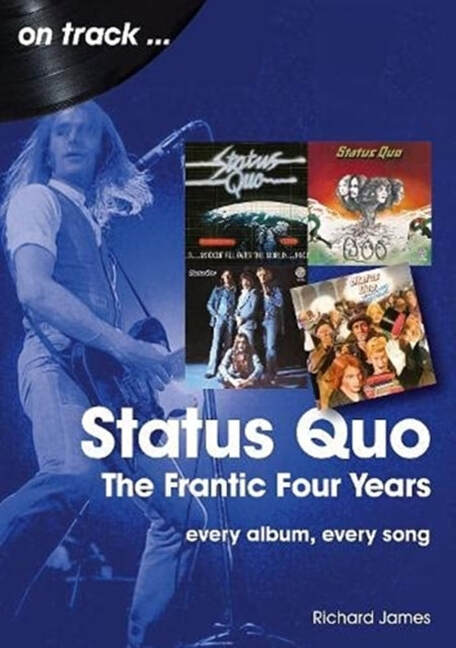
STATUS QUO – The Frantic Four Years, Every Album Every Song by Richard James (published by Sonic Bond) Status Quo may still exist, albeit with only one original member (Francis Rossi) but few fans are as enthusiastic about the albums they’ve released in the last four decades as they are about those recorded in the early Seventies. Although they achieved healthy sales and scored hit singles, few of the records released since then have even come close to the quality of the albums released between 1970-1977 (‘Ma Kelly’s Greasy Spoon’ through to ‘Rocking All Over the World’.) During that time, the band developed a powerful mix of hard rock and melodic riffs, which would be offset on their albums with ballads, blues and even psychedelic pop. However, it was their no-nonsense approach that really set them apart, particularly as a live band. In the era of Prog and pretention, Status Quo kept things straight to the point, much to the chagrin of many music journalists who would dismiss them as ‘three chord wonders’. However, supported along the way by the likes of John Peel and an army of loyal fans, their records continued to reach the top of the charts. Unfortunately, in 1977 the lighter production of ‘Rocking All Over the World’ saw them crossover to an even wider audience and, whilst this may not have been a conscious decision, their ensuing albums adopted a much more radio-friendly approach. The songs weren’t necessarily bad, but the production seemed to sap all the energy and edge which had previously made them special. Over the following years, further albums continued this lame direction and, despite a few decent tracks hinting at their former greatness, the band gradually fell apart and split-up in 1984. This proved short-lived as they famously reformed to open the Live Aid concert at Wembley in 1985 and subsequently decided to continue, albeit with only two original members, Francis Rossi and Rick Parfitt. The subsequent album, ‘In the Army Now’, was truly horrendous and they never made-up for it. In fact, the only real event of any value from that point onwards were the reunions of the original ‘Frantic Four’ members in 2013 and 2014 (Alan Lancaster and John Coghlan alongside Rossi and Parfitt) giving fans a final chance to see the real Status Quo. Those dates were magnificent and effortlessly showed why the original band had been so special, much in the same way that the original Alice Cooper Band had been so great, but Alice Cooper as a solo artist is so hit-or-miss. However, the lazy put-downs about the band still continue and, while their post-70’s releases haven’t done much to help their reputation, it’s still surprising that their 1970-77 output isn’t held in much higher regard. This book does a lot to redress the balance. Richard James is obviously an avid fan of the bands’ classic output, but he also retains a good sense of humour about the subject and isn’t afraid to say when the band were either lacking or just plain awful. He also has enough musical knowledge to completely trash the ‘three-chord’ myth and pays all-due-respects to the bands more ambitious compositions, such ‘Big Fat Mama’ or the album-version of ‘Mystery Song’. Despite the title, this tome tells the story of the band from their roots as The Spectres in 1962 all the way through to the passing of Alan Lancaster in 2021. Although the details aren’t as thorough for the pre-1970 and post-1984 years, they need to be there to put the Frantic Four years in proper perspective and highlight an era that you may otherwise have missed-out. In many ways, Status Quo were forerunners of pub-rock and subsequently even Punk, in the way they stripped-down their music to avoid unnecessary muso-isms (no solo’s!) and even adopted a basic stage presence (denim and t-shirts.) There’s a clip you can find online of the band playing live at the Marquee in 1972 and the parallels to The Ramones or even Nirvana are quite noticeable… Check it out if you don’t believe me! At the end of the day, it’s up to you, but if you read this book you may well discover some great music that you might otherwise never hear. Trust me, it will be worth the effort.

RADIOHEAD – Every Album, Every Track by William Allen (published by Sonic Bond) I was intrigued by this book as I quite like some of the music I’ve heard by Radiohead and also appreciate their approach and attitude, but as there’s such a lot of material in their back catalogue, I really didn’t know where to start listening. First and foremost, this is a book from a fans’ perspective, so instead of concentrating on the ‘big hits’ or media-acknowledged ‘classics’, it deals with the music that the fans themselves actually enjoy. As such, it provides all the pointers that you need to start your investigations. I’ve certainly made more than a few mental-notes about records that I’m going to check-out further and for that alone, this is a very useful and informative book. On the other side of things, however, is the technical-depths that William Allen is fond of indulging. As a guitar-tutor who studied Music at university, he delves into the muso-side of things a bit too much for my liking, as it treats the band more like a prog-rock project than an organic entity. That said, his obvious passion for their music provides a good balance for those excesses, so the book remains interesting and readable throughout. One other aspect about Radiohead that’s also intriguing to note is the way in which they’ve tackled the whole subject of streaming and downloads, using it to make exclusive and rare material available to their fans on their own terms in a fair and respectful way… I’m sure there’s a lot of other bands that could learn from their example. So, even as someone who’s not a particular fan of the band, I enjoyed this book and have no problem recommending it. It will appeal more to established fans, but even if you’re only curious about the band, there’s plenty of information to explore.
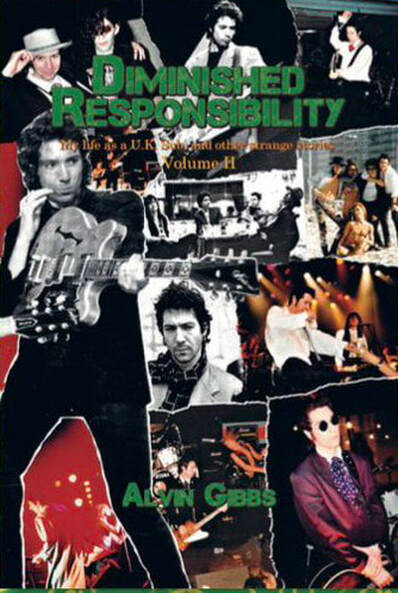
DIMINISHED RESPONSIBILITY Volume 2 by Alvin Gibbs (published by Tome & Metre books.) Having previously written and published a book about his time on tour with Iggy Pop, Alvin is currently compiling an extensive, three-volume autobiography covering his entire career from early bands right through to the present day. Volume 1 took us as far as his departure from the UK Subs in 1983, while this latest book covers from then up until 1995, when Cheap & Nasty, the band he had been playing with, split-up. Between these dates, he has numerous tales of the various bands and individuals he played with during that time, starting with the short-lived group ‘Target Generation’, which he formed with Nicky Garrett soon after they’d left the UK Subs. Although initially optimistic about their new project, things gradually went askew when it turned out that their new singer had a serious drug habit. Alvin chose to depart from this situation, before being asked to join Hanoi Rocks in 1985. Initially keen on this opportunity, he soon found the band to be in a rather dysfunctional state and again departed before things got too involved. After this, he decided to try his chances in America, first moving to San Francisco before heading to Los Angeles, where he was soon playing music again, firstly with a band called Revolver and later on with another group called Broken Glass. But it was in 1988 that he received a call enquiring if he’d be interested in joining Iggy Pop’s touring band… as mentioned above, most of this particular tale is told in his earlier book ‘Neighbourhood Threat’ (recently re-published as ‘Some Weird Sin’) so Alvin doesn’t repeat the full story here, but instead gives a shorter version of events including some tales not included in the previous book. After this particular story, Alvin returned to London in 1990 to join a new rock band called Cheap & Nasty, formed by former Hanoi Rocks guitarist Nasty Suicide. Initially, things seemed to go well for the band. Their early gigs were met with enthusiastic audience response and they soon had interest from record companies, but they unfortunately fell-foul of dodgy record label / management, who reneged on their contract and insisted on having their debut album remixed, resulting in a lack-lustre version being released to the public. Further difficulties arose leading to a change of management and record label, whilst the band continued to be a popular live act both in the UK and abroad. Their second album saw them successfully touring in Japan, but personal issues eventually led to the band splitting-up in 1995, which is the point where this volume ends. Alvin adds many details and to all of these stories, as well as non-musical episodes involving martial arts and skydiving, as well as many personal details. He writes very well, in an engaging and entertaining style that manages to include many impressive events without ever coming across as big-headed or arrogant. Basically, this book is a lot of fun and I think it will appeal as much to fans of rock music in general just as it will to die-hard UK Subs fans or fans of Alvins’ other bands. Together with loads of previously unpublished photographs, this is a great story that’s both amusing and inspiring. Highly recommended!
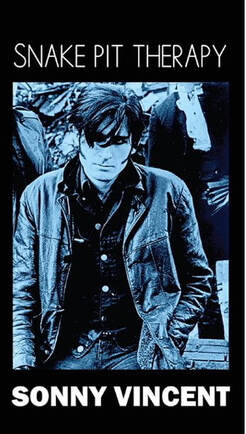
SNAKEPIT THERAPY by Sonny Vincent (published by Far West Press) Published in conjunction with the latest Sonny Vincent album (of the same title.) However, this isn’t directly related to the songs on that record and instead, this is almost like a taster of Sonny’s written work from different times, ranging from biographical extracts and satire through to fiction and more experimental pieces. Some of the chapters are more instantly enjoyable than others, but there’s nothing bad with these pages and the different chapters work well to compliment each other within this volume. In many ways, the book reflects Sonny’s musical direction and intent over the years, adding another facet to his ongoing creativity. None of it is predictable and some of it is erratic, but there seems to be an indefinable purpose that continually drives the author towards his next statement. As I said, this is almost like a taster (it’s only 100 pages long) but it opens up so many possibilities, most obvious being that if Sonny writes a full biography it would surely be a worthwhile and enthralling tale. Let’s just hope that some publisher has the good taste to offer a deal for it soon!
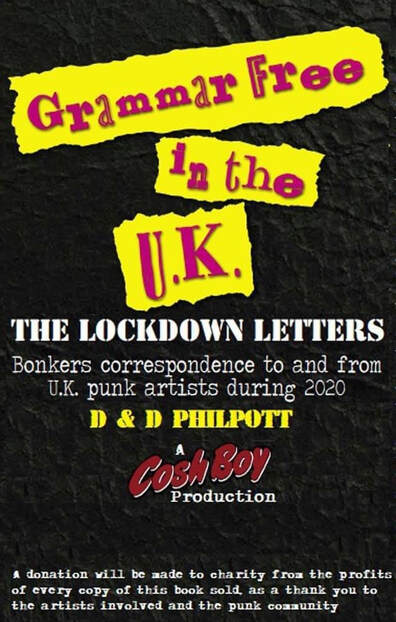
GRAMMAR FREE IN THE UK – THE LOCKDOWN LETTERS by D & D Philpott (published by Irondig Books) There’s a good chance that you may have already come across one of the books by these two alleged brothers, as they have previously produced books in a similar style (‘Dear Mr Kershaw’ and ‘Dear Mr Pop Star’). Basically, they pick on musicians and send missives full of bizarre misinterpretations and inane enquiries. They then wait for their subjects to reply and, the more indignant or confused the response, the better. It can result in some vey funny communications, although as the prank has continued, knowledge of their scheme has spread and is no longer so likely to have the full effect on the chosen targets. Regardless, during 2020 and with nothing better to do, they set-about contacting various bands and musicians from the current UK Punk Rock scene. The replies are often pretty collaborative, with the respondents clearly aware of the Philpotts’ scam, but they can still evoke plenty of laughs. Bands that get-in on the joke include the likes of Cockney Rejects, UK Subs, The Rezillos, Gang of Four, Eater, Cock Sparrer, The Membranes, The Mob, the Mekons, Ruts DC and even The Snivelling Shits! It’s probably not the kind of book that you should read in one-sitting, as the premise does get a bit repetitive, but if you dip into it with a few bands at a time, it works really well. It’s not a book that will change your life but it’ll help to pass the time!
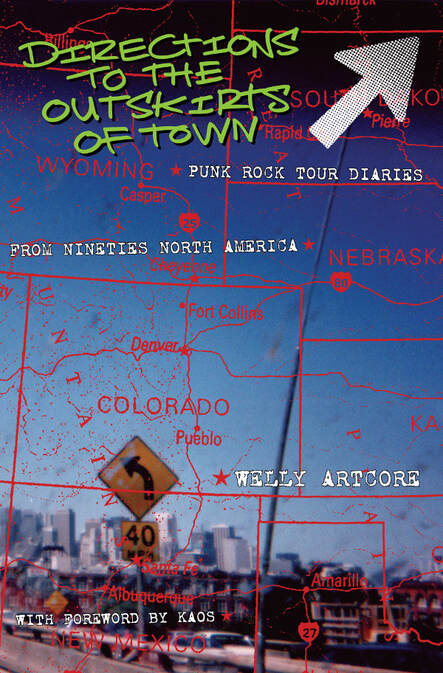
DIRECTIONS TO THE OUTSKIRTS OF TOWN by Welly Artcore (published by Earth Island) Based in South Wales, Welly has been producing his ‘Artcore’ fanzine since 1986 and it continues to be highly recommended. This book, however, takes a sidestep from that publication to focus on his band-related travels around America, firstly as a roadie for legendary Cider-swiggers Chaos UK in 1994 and then, four years later, as the singer for his own band, Four Letter Word. As most bands will tell you, touring is not the best way to really see a different country as the schedule, more often than not, does not allow for ‘tourist’ opportunities and the time you really need to get a sense of the places you visit. However, touring does give you an interesting perspective on those places and the people that live there. On top of this, no two tours are the same, so you’ll always encounter situations that will be unique to your experience, even though others will be straight from ‘This is Spinal Tap’. Plus, it is almost inevitable that the worst things that happen will be the ones that you’ll laugh about the most, once the tour is over… Basically, it’s something that you should try to do at least once in your life, should the opportunity arise. In Welly’s case, that chance first came along when he got the call to roadie for Chaos UK during their US tour. Although not a hugely-popular band, Chaos UK had enough of an underground reputation to ensure decent attendance at their gigs and more than a good chance of not losing money by the end of the trek! That being said, they still have to put-up with less-than-desirable conditions in some places and many mishaps, courtesy of both the promoters and their own chaotic ways of getting things done. But it also allows for plenty of hilarious events (at least, when seen in retrospect) and it’s that sense of humour that really draws you into the tale. Four years after this first excursion, Welly got the chance to tour as the singer in his own band, Four Letter Word. Having released an album, ‘A Nasty Piece of Work’, on the LA-based BYO Records, dates were set-up for them, mostly supporting other more-established bands such as 7Seconds, Youth Brigade and the Swingin’ Utters. But there was still plenty of space for things to go askew and rest assured, there are many such occasions to provide the drama within this tale. The big difference between this tour and the one with Chaos UK is that, as part of the band, there’s a lot more stress and responsibility about how things work-out. However, yet again the tale is often funny and it’s all written in a down-to-earth style that allows it to become vaguely familiar and highly engrossing. The great thing about books like this is that, although Four Letter Word may never have become widely-popular, they did achieve things like this and, by documenting the events, it also shows that these things are possible. It’s just up to you to find a way to do it! At the end of the day, you should read this book because it’s very entertaining, but you may well find it to be a source of inspiration for your own journeys…

HEART ON MY SLEEVE – COLLECTED WORKS 1980-2020 by Attila The Stockbroker (published by Cherry Red) I first heard Attila the Stockbroker on the John Peel show (where else?) in the early Eighties and saw him perform live on several occasions over the next few years. At the time, his poems were mostly humorous but always had underlying points that were both poignant and thought-provoking. Since then, Attila has continued to write and tour, both as a solo performer and as part of the band Barnstormer, and on the occasions when I’ve seen him, he’s always been very entertaining even if his poems and lyrics tend to be more serious these days. This book sets out to celebrate his 40 year career by presenting a thorough overview of his work to date. Divided into appropriate sections (‘Little England’, ‘Recent Realities’, ‘Domesticity’ etc) rather than chronologically documenting poem-by-poem, the book works really well as it delves into the different subjects and observations that matter to Attila. It also documents how things have (or haven’t) changed during those four decades, with themes and topics being influenced by the Thatcher years, through Blairs’ regime and culminating in Bullshit Boris… no wonder he still feels compelled to write! From the wry, witty words of his early poems (‘A Bang and a Wimpy’, ‘Russians in the DHSS’) through to genuinely moving statements (‘Contributory Negligence’) and powerful satire (‘The Bible According to Rupert Murdoch’) you’ll find plenty to enjoy and think about within these pages. It’s a shame that there are no longer the places/people willing to give mainstream access to artists like Attila (in the early Eighties, he could be heard on Radio One and seen on the cover of national magazines like Melody Maker) but I doubt this disheartens the man and, indeed, as the more recent work included in this book illustrates, he seems just as focused and determined as he has ever been. This book deserves to be read and Attila more than merits your attention. Let’s hope he’ll be around for another forty years!
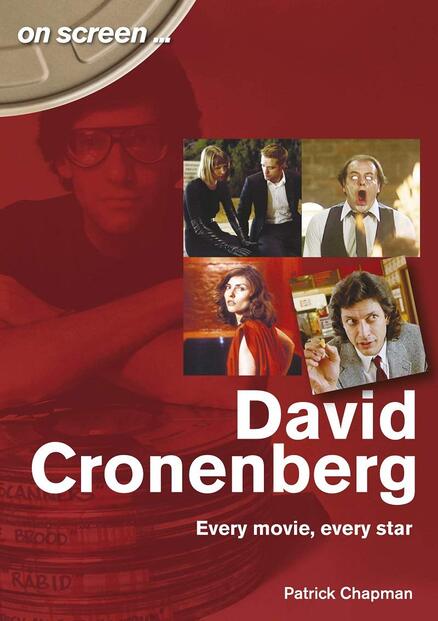
DAVID CRONENBERG – EVERY MOVIE, EVERY STAR by Patrick Chapman (published by Sonic Bond) It wasn’t until I read this excellent book that I realised just how many of Cronenbergs’ films I’ve actually seen and enjoyed (and how many I still need to see!) I first came across films like ‘Rabid’ and ‘Scanners’ in the early-Eighties when I became interested in Horror movies, but it wasn’t until I saw ‘Videodrome’ that I realised there was something more to this director. Of course, my initial interest in that particular movie was the involvement of Debbie Harry (I was a teenage boy at the time, after all) but I soon found the film involved much bigger issues and left me with plenty to think about. Further on, Cronenbergs’ films continued to intrigue me, even as they teased the mainstream. ‘The Fly’ introduced his themes and interests to a much wider audience whilst maintaining its’ credibility, and ‘Naked Lunch’ took aspects of the ground-breaking novel together with episodes from William Burroughs’ own life to create something new rather than a direct cinematic reproduction (which probably would not have worked so well on film, anyway.) ‘eXistenZ’ presaged the current widespread-infatuation with computer games, suggesting the dangers and imagining the ultimate follies. ‘A History of Violence’ came close to being a classic gangster movie, but the issues of self-identity and false personas raised it to a whole other level. Cronenberg, now in his Seventies, made his last movie to date, ‘Maps to the Stars’, in 2014 and at present there seems to be no plans for more, although this, surprisingly, is down more to the difficulties he has raising the finances for his films rather than the loss of his energy or enthusiasm. What this book sets out to do is present a well-considered history and appreciation of Cronenbergs’ work and does so in an intelligent but unpretentious way. As such, the it’s very accessible and enjoyable, even though it does tackle the intellectual ideas that the films raise. It’s particularly interesting to see how certain aspects of the films have actually become more poignant over the intervening years and how certain points that may not have been so important at the time are now highly significant. This is a book that gives you plenty to think about and adds even further depth to Cronenbergs’ work, whilst at the same time, much like the movies themselves, never loses the ability to entertain. If you’re not already familiar with Cronenbergs’ movies, then this book is an ideal place to set you on the right path. If you are already a fan, then this will add even more to your understanding and enjoyment of the films. Either way, this is a pretty essential guide.

SAFETY PIN #9 (www.safetypinmag.com) New issues of Safety Pin seem to appear at a rate that puts me to shame (similarly, Safety Pin’s print-quality is also highly impressive, but there’s only so much shame that I’ll admit to…) With everything that’s been happening over the past year and my own efforts to get the printed Fear & Loathings up to date (I did it!) I must admit I’ve missed-out on a few reviews that I should have included but you can still find all the info that you need at their website (see above.) Anyway, now that I’m a bit more organised, this is the latest issue to come crashing through the door and has yet more of the selection of great interviews and features that make this such an essential read for anyone interested in the current Punk Rock world. Big interviews with Bundie (ex-The Business, currently part of Kicked in the Teeth) which focuses mainly on the late, great Micky Fitz, the peculiar guitar-pop of The Lovely Eggs, Rabies Babies and Lucy & The Rats. Plus you get a 7’’single featuring one side each from Maid of Ace and Dee Skusting & The Rodents. The MOA track, ‘Devil in the Belfry’ is a remix and so quite different to their usual live delivery, while DS&TR provide a frantic, catchy punk rock tune called ‘Vacant Night’. Safety Pin takes chances with the music they cover but it all comes together in the greater scheme of things… good music is just good music, after all! You don’t have to agree with all of their opinions, but at the same time they may just introduce you to your new favourite combo. Safety Pin is essential reading as it comes from the same roots that got us into this music in the first place and if you can’t dig this, as the saying goes, you really can’t dig nothin’!

THE SCENE THAT WOULD NOT DIE by Ian Glasper (published by Earth Island) One of the things that has always irked me about Punk retrospectives (either books or documentaries) is that they almost always focus entirely on the 1976-78 period, implying that the movement died after that brief period and completely ignoring the fact that Punk has continued to spread and evolve all over the world. Arguably, the UK ‘anarcho-punk’ scene of the early Eighties was just as influential as the original scene… as someone said, ‘the Sex Pistols showed people you could do it yourself, while Crass showed people how to do it yourself.’ Over the course of five books, Ian Glasper has attempted to rectify the situation by diligently covering many of the ongoing aspects of UK Punk Rock that are usually omitted. ‘Burning Britain’ and ‘The Day the Country Died’ covered the ‘UK82’ and ‘Anarcho’ scenes respectively, while ‘Trapped in a Scene’ documented late Eighties UK hardcore. ‘Armed With Anger’ continued through the Nineties and now, ‘The Scene that Would Not Die’ brings everything up to date, from 2000 until now. This is a pretty hefty tome, over 600 pages, which certainly gives the lie to anyone who thinks punk rock isn’t around anymore. In fact, it could be argued that successful bands like Sleaford Mods and The Idles have plenty of punky DNA in their make-up, but before we get into those kind of permutations, this book concentrates more on the grass-roots / DIY movement. Over 100 bands are featured and whilst many may feature musicians who have been around for quite a while prior to 2000, there are just as many that have been formed by teenagers who have only embraced punk in recent years. The range is impressive, from bands with serious political motivation through to others who just want to have fun, while musically the styles veer from D-beat and hardcore through to melodic and post-punk influences. As I read through, I ended up making notes on the bands that I wanted to investigate further and, with the aid of bandcamp etc, I’ve already found several that I’ll be hoping to see live in the near future! Admittedly (being an older bastard) I do love a lot of older bands, but I still find it exciting to discover new, younger bands that blow me away. I mean, who wants to just stand in one place? Bands like The Menstrual Cramps, Sanction this and Natterers have been responsible for some of the best and most vital record releases in the past couple of years, proving that you really need to keep listening for what’s going to happen next. As with his previous books, Ian allows the individual bands to provide all the necessary background and information about themselves without trying to impose his own interpretations. Of course, some bands will come over better than others but that also depends on your own preferences. In a world where no-one has enough time to listen to everything, this book will at least point you in the right directions. In theory, this is Ians’ last book on the UK punk scene(s) but then again, who knows what might happen next year? A whole new scene might burst into existence… I just hope there’ll be someone there to document it as well as this book has done.
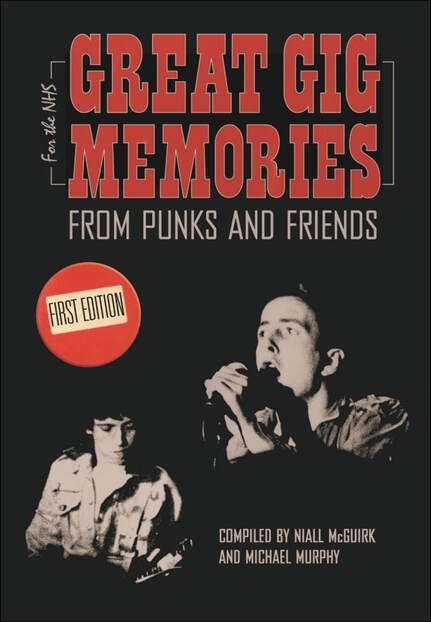
GREAT GIG MEMORIES compiled by Niall McGuirk and Michael Murphy (published by Hope Publications.) The Hope collective is a Dublin based DIY organisation that has been promoting gigs and other events since the Eighties. They’ve also published several books over the years and this most recent volume was their response to the Covid pandemic, inviting people to share their musical memories to raise funds for the NHS (all proceeds go to NHS Charities Together.) Certainly, it’s a very worthy cause and the amount of work involved to put it all together at such short notice can only be commended. Fortunately, they were able to obtain articles from a wide range of people, both musicians and fans, who have written about a varied selection of concerts. Knox, for example, recalls a Jimi Hendrix gig at the Manor House pub in North London, whilst Charlie Harper writes about going to see the Mothers of Invention at the Royal Albert Hall (and finding himself sitting alongside Jimi Hendrix!) So it’s not all about punk rock, even though most recollections tend to lean that way, and in a lot of ways that’s what makes this such an enjoyable book. People are writing about the way they felt when they attended or played these gigs and, even if they’re talking about bands that you personally may not like, you can still relate to the feelings and emotions that they recount. There are stories about some gigs or bands that have since become legendary and tales about others who are relatively obscure, but they are always intriguing and enjoyable because we’ve all been in similar situations and can smile to ourselves as we recognise the parallels to our own experiences. Sometimes things go right, sometimes things go wrong, but in retrospect they can all become great memories. You’ll possibly even come across a story about a gig you also attended and reading another person recollections can add a whole new perspective to your own memory banks. So, be sure to buy a copy of this book. It’s highly entertaining and it’s there to support a great cause. You really don’t have any excuse to miss it.
www.hopecollectiveireland.com
www.hopecollectiveireland.com
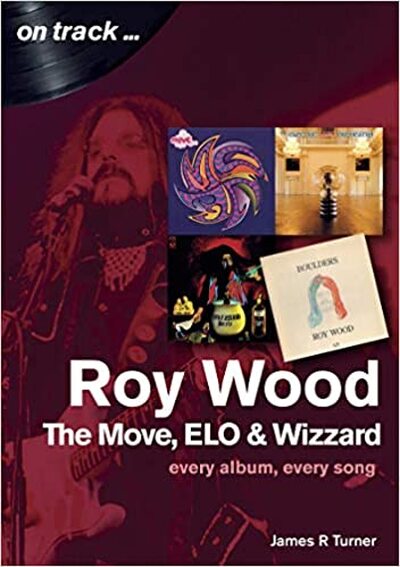
ROY WOOD, THE MOVE, ELO & WIZZARD – EVERY ALBUM, EVERY SONG by James R Turner (published by Sonic Bond.) Roy Wood remains best known for the Xmas party classic ‘I Wish it Could be Christmas Everyday’ but his career has involved numerous top ten hits, several very successful bands and a genuine claim as one of the best UK songwriters of the past fifty years. This book covers his entire output since the Sixties and puts his talent in both the pop and rock genres in sharpened perspective. Wood had been involved in the Birmingham music scene from the mid-Sixties but it was when he joined The Move that things really started to come together. Over a seven year period, the band scored nine Top Twenty hits including ‘I Can Hear the Grass Grow’ (later covered by The Fall) and ‘Flowers in the Rain’ which has the distinction of being the first record broadcast on Radio One. They released four albums before their final line-up, which also included Jeff Lynne, morphed into the Electric Light Orchestra. Wood remained a vital part of the initial ELO line-up, co-writing and recording their debut album before deciding to leave and form his own band, Wizzard. Arriving at just the right time to ride the wave of Glitter Rock, Wizzard combined elements from early rock’n’roll with a Phil Spector-like wall of sound to create songs that were catchy and stomping. Whilst Wizzard remained in the pop charts, Wood also released two solo albums which allowed him to explore his own music aside from Wizzards’ popular style. However, from 1977 onwards, he seemed to move away from his mainstream career. Wizzard split and he formed The Wizzo Band who, despite the reference in their name, were quite unlike his previous group, leaning more towards jazz-rock! This project split after only one album and since then, Wood has only occasionally recorded and released new material although he does still perform live and tours with the Roy Wood Rock’n’Roll band. This book covers all aspects of his career, including the often-overlooked but vibrant Birmingham music scene of the mid-Sixties, and whilst it has no direct input from the man himself, author James Turner has done as fine a job as anyone is ever likely to achieve. This is a great book whether you’re already a fan of Roy Woods’ music or not, as it tells a great story and also provides the background to a great selection of songs. Once you read this, you’ll be itching to go out and investigate the back catalogue, so it can only be said that the book does its’ job properly!
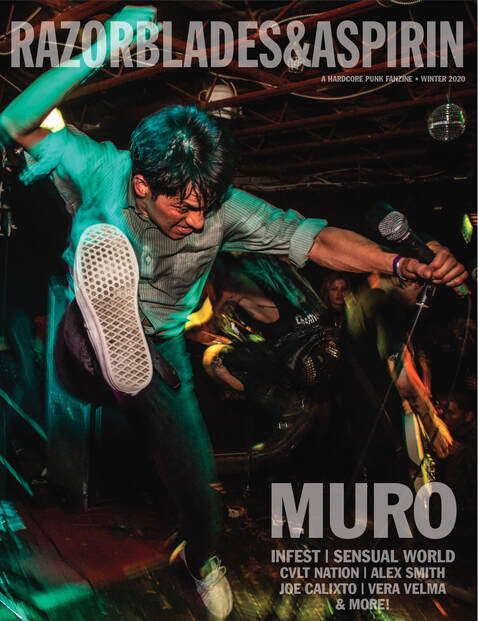
RAZORBLADES & ASPIRIN *11 (www.razorbladesandaspirin.com) Sometime last Summer, during one of the botched-attempts to lift ‘lockdown’, I was at All Ages record shop in Camden and Nick showed me a copy of ‘Razorblades and Aspirin’, a very impressive fanzine from Richmond, Virginia. Predominantly based around the photographic work of Michael Thorn, it included hi-quality images of great bands from the punk and hardcore scenes as well as a selection of interviews and articles. I hung my head in shame when confronted by such quality… well, not really. FNL may be an old school cut’n’paste affair but I’m not ashamed - it’s what I enjoy and the website can pretend to be a bit more professional! Anyway, fast-forward a few months and I receive an unexpected email from Michael himself, asking if he could re-print my (fairly-recent) Infest interview in his upcoming issue. I was more than happy for him to go ahead with this (note for other zine-editors – I’m usually happy to let other fanzines borrow material, as long as you let me know in advance and send me a copy of the finished product…) So, a few more months down the line, a copy of the latest ‘R&A’ arrived in the post and, apart from making me feel graphically-inadequate, it’s a totally excellent publication. Featuring interviews with Muro (Colombia), Sensual World, Cult Nation and many others, plus superb photography (both full colour and black & white) this is a fanzine that looks great and provides all the information you need to go out and find your latest punk rock fix. Unfortunately, the print-quality makes this publication makes it a fairly limited artefact, but check out their website and (if you’re in the UK) the aforementioned All Ages may well be able to help you out. Either way, this is something that you need to see!

VAN DER GRAFF GENERATOR – EVERY ALBUM, EVERY SONG by Dan Coffey (published by Sonic Bond.) I’ve been wanting to investigate VDGG for a while, but with such a large back catalogue (especially when you include Peter Hammills’ solo albums) it really was hard to know where to start. This book discusses all the albums and provides all the information you’ll ever need. As the author explains, the Hamill solo albums should be included and they often involved the same personnel as VDGG themselves, the only difference being that while musical input on the VDGG albums was pretty-much down to the individual musicians, Hamill would serve more as a sole musical director on his own records. VDGG are often referred to as part of the Prog Rock genre, but the more you delve the more you’ll realise that this isn’t really the case. They embrace a huge range of musical styles, some experimental, some quite abstract and some that really rock. In many ways, they’re actually closer to some of the music created by the likes of Faust, Can or King Crimson, so you can see why the likes of John Lydon, Mark E Smith and Julian Cope have all been fans. There have been three eras for the band, initially from 1969-71, from 1975-77 and then, more recently, from 2005 to present. Inbetween and during these periods, Hamill has released numerous solo albums, so the output has been pretty continuous. Of course, it depends on which fan you talk to and which era is their personal favourite, but there is a lot of interesting music to discover from all eras… if you don’t enjoy the first thing you hear, don’t give up, because the next one may very well blow you away. Where this book is invaluable is the way the author combines the obvious enthusiasm of a fan with an objective approach that highlights the bands’ musical successes, but also isn’t afraid to note when things didn’t come together so well. It’s well-written and very knowledgeable, but never comes over as patronising or obsessive, allowing the reader to really discover the band and their records for themselves. I’ve already started investigating and, so far, I’ve been pretty impressed. Read this book and it may well open you up to a whole new realm of music.
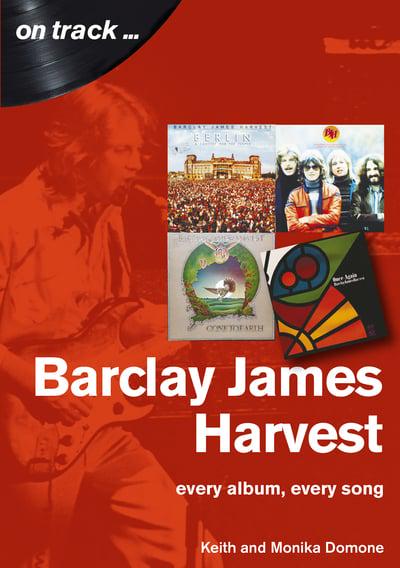
BARCLAY JAMES HARVEST – Every Album, Every Song by Keith and Monika Domone (published by Sonic Bond.) This is a difficult one to review, the problem being that I’m really not a fan of this band. Formed in 1967, their early music combined rock with folk and classical arrangements in an almost pastoral style. Whilst there’s no denying the bands’ obvious musicianship and unique style, it’s all a little too mellow for me, I’m afraid… north-west Englands’ answer to The Eagles, perhaps. Regardless, they attained a steady, loyal fan-base in the UK, but it was in the rest of Europe where they began to be embraced by a much wider audience, especially as their music moved towards a much more Eighties-sounding production. Their popularity culminated in an open-air concert in Berlin during 1982 which attracted an audience of 250,000! With the stage built directly in front of the historic Reichstag building, only a short distance from the Wall, this event became more than just a concert. With the city still divided, their music could clearly by music-fans in East Berlin, signifying and encouraging a sense of unity. The band continued until 1998, when it split into two separate groups. This book is well-written and, as such tomes are expected to do, provides all the information and details that you would want about the subjects. As I said, I can’t count myself as a fan and reading their story here hasn’t converted me, but there are some interesting tales to discover and I’m sure that fans are going to find this fascinating.
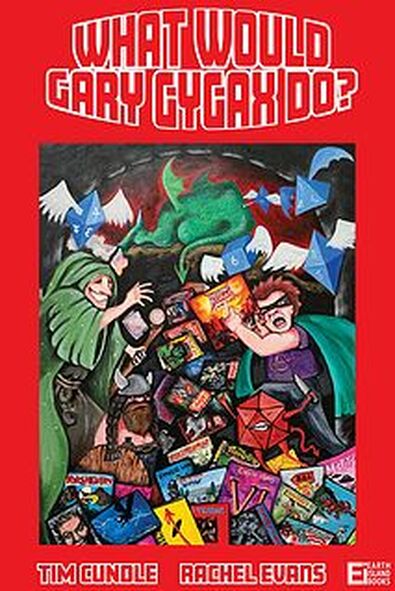
WHAT WOULD GARY GYGAX DO? By Tim Cundle and Rachel Evans (published by Earth Island) This is quite a different offering to Tims’ previous book, ‘Compression’, in that this work is a collection of relatively short articles and anecdotes rather than a complete novel. Also, whilst Rachel Evans provided artwork to accompany ‘Compression’, her illustrations are a much more integral part of this book and serve as effective glimpses into the core of the words, which more than merits her co-authorship. The style and tone of the various pieces does vary a lot, with some being lucid, biographical tales that are easy to relate to whilst others are more personal and intense. It’s the balance between these two that maintains the tempo of the book, ensuring that it never becomes too light or too dark. One thing that might have been interesting would have been to know when the individual pieces were actually written… I’m guessing that it may have been over quite a period of time, which would account for the construction of the book in this more accessible way. Whatever the case, the format allows you to read through at a seemingly fast pace, flitting from one piece to the next (at nearly 400 pages, that’s quite a feat in itself.) There are some chapters that refer to events and people in a rather vague way, talking about certain unspecified occurrences but not really clarifying what they were. This can add to the overall intrigue but can also be a little frustrating as you’re left hanging, unsure what conclusion you should draw? But that’s not so much of a problem when put into the context of the whole book. This is a book that has many twists and turns, but is something that will draw you in deeper with every page you read. And, by the way, if you can’t wait to find out… Gary Gygax was one of the creators of Dungeon & Dragons… and, no, I didn’t know that either!
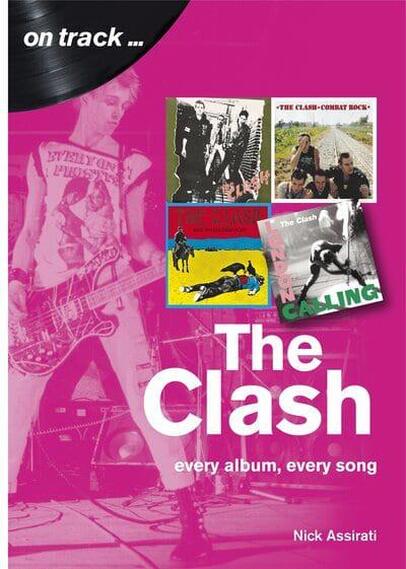
THE CLASH – EVERY ALBUM, EVERY SONG by Nick Assirati (published by Sonic Bond) In theory, The Clash are a perfect subject for a book like this, with six albums that neatly define their eight-year career. The only problem is that The Clash, possibly more so than any other original UK punk band, still divide opinions. If you put a dozen Clash fans together in a room listening to all of the original albums, they’d never agree about everything and, indeed, The Clash were a band with many contradictions, so it’s not surprising that this would happen. Undeniably, they made some of the greatest music to emanate from the 1977 era, but few fans love everything that they released. Similarly, they were a band that many people really believed-in, but as time went on they were probably accused of ‘selling-out’ more than any other. A book like this, documenting each and every release with background information and descriptions, is obviously going to be subjective and therefore lay itself open to contrary opinions. As long as you can accept that, it shouldn’t be a problem, but as much as Nick Assirati has done a thorough job, his personal thoughts will still stir-up emotions. He concentrates mostly on the musical content and does a very good job with it, describing their debut album as ‘something fresh, something different’, which basically hits the nail on the head. It was raw, it was direct and it captured the spirit of the day. Over the decades it’s probably been imitated more than any other ‘punk’ album apart from the Ramones (by the way, is it only me or does ‘White Riot’ owe more than a nod to New Yorks’ finest?) Moving on to ‘Give ‘em Enough Rope’, he details the background (trips to Jamaica, the hiring of established producer Sandy Pearlman and recording sessions at studios in London, San Francisco and New York) which all provided reasons for the music press to generally dislike the album. However Nick recognises that the band had simply moved on, but still maintained their energy and intent. ‘London Calling’ is now usually regarded as the bands’ high point and, considering that it was recorded following the sacking of their Svengali-like manager Bernie Rhodes, really should have established them up in a unique position, reaching a much wider audience whilst retaining their credibility. I do disagree with claims that every song was great and I often skip side four altogether, but the album certainly lives up to its’ reputation and, as Nick states, it remains ‘one of rock’n’roll’s truly great records’. However, moving onto ‘Sandinista’, I have to say that Nick’s assertion that it’s a ‘flawed masterpiece’ is something many will disagree with. Yes, it is eclectic and the band did embrace many different sounds and styles, but unlike ‘London Calling’, it lacks focus and direction. There are some really great songs on there, like ‘The Magnificent Seven’, ‘Somebody Got Murdered’ and the incendiary cover of ‘Police on My Back’, but to my ears, over a triple album it just seems to meander too much. Evidently some of the band also felt this way as they re-hired Bernie Rhodes before starting work on the next album. He immediately insisted that it should be a single album and also rejected the original mixes as made by Mick Jones, in favour of a remixed and edited version produced by Glynn Jones (no relation.) The results and the response to ‘Combat Rock’ left the band with a real conundrum which Nick eloquently sums up – it was ‘the weakest of (their) albums but paradoxically their most commercially successful’. Again, it does contain some great songs – ‘Should I Stay or Should I Go’, ‘Rock the Casbah’ and the awesome ‘Straight to Hell’, but the production lacked the energy and insight that it could have had. It would also lead to the collapse of the band – Mick Jones was beginning to feel isolated and Topper Headons’ drug problems were getting out of control, while Bernie Rhodes seemed to be pursuing his own ulterior motives. Topper was sacked soon after the album was released and Mick would suffer the same fate once the subsequent touring was completed. Nick states flatly that ‘this was the end of The Clash’ and for all intent and purposes, it’s true. However, the demise wasn’t immediate. Joe Strummer and Paul Simenon, prompted by Bernie, recruited two new guitarists and a drummer in an attempt to reclaim the original spirit of the band. This is, alongside ‘Sandinista’, probably the most controversial period of the bands’ career. It is often entirely ignored in retrospective documentaries or compilations and Nick is obviously content to follow-suit, describing the final line-up as ‘Not The Clash’ or ‘The Pantomime Clash’ and wasting very little print on the songs. Certainly, ‘Cut The Crap’ is not a very good album, although ‘This is England’ is a fine song and could have been even better with a decent production. The new line-up itself wasn’t as terrible as some make out and there are live recordings that capture a tight and very powerful band, whilst bootleg recordings of new songst showed a lot of promise. The big problem was that, with Joe enduring a series of personal problems, Bernie Rhodes decided to take-on production duties and, basically, ruined any chance the album might have had. I’m not saying that it was ever going to be a great Clash album, not without Mick Jones’ involvement, but it could have been something that wasn’t universally disliked. Could have, might have… we’ll never know. But I think that final line-up deserves a little more respect even if the album doesn’t. But as I said at the beginning, this is Nicks’ book and its’ his opinions, so there’s no point in getting precious about it. Reading through, I found out a few things that I didn’t already know and he pointed me towards a few songs that I’m glad I subsequently checked out again. If, as an old or new fan, you want something to help you put The Clash in perspective, this is a good guide even if you won’t agree with everything. To my mind, that’s exactly what a book like this should be doing.
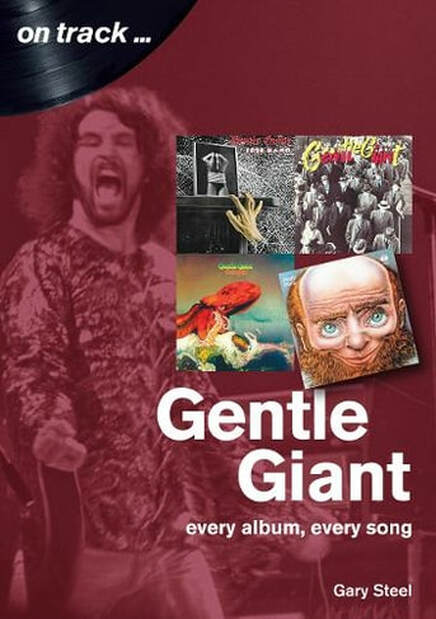
GENTLE GIANT – EVERY ALBUM, EVERY SONG by Gary Steel (published by Sonic Bond) This book arrived in the post one day and presented a bit of a dilemma. Up until this point, I don’t think I’d ever heard anything by Gentle Giant, so should I check out some of their music before I read the book, to put it into perspective, or should I read it first, to see if it interests me enough to want to investigate the band? I decided to go for the latter option and, on that basis, here are my conclusions. Firstly, the book is very well written, by someone who has clearly been a fan for a long time. At first, this does create some suspicions as the early albums are reviewed with much praise and few faults, so you can’t help but think the comments are made by someone with too much personal bias. That being said, as the bands’ career continues, some of the later albums do receive negative criticism, which gives the book an overall balance that isn’t just subjective. The stories and details about the band and their efforts to succeed are intriguing and, especially when you consider the complex music they were releasing, it’s quite impressive that they produced so much (eight albums from 1970-76.) They may have been considered part of the Prog-rock contingent, but they certainly weren’t interested in excessive studio projects as some of those bands indulged in. The thing that does put me off is the regular references towards medieval an early musical forms, which instantly sounds pretentious although, without hearing them at this point, I can’t really confirm that aspect. There are also more than a few references to the bands’ ‘giant riffs’ and comparisons with King Crimson / Robert Fripp (one of the more interesting bands of that era.) So, the book is definitely working and I do become interested in hearing Gentle Giant or, at least, the albums that are recommended. So, eventually I put youtube to use and listen to a selection of their music. Having been persuaded that ‘Octopus’ is perhaps their best album, that’s the one I concentrate on and, even though I remained wary, I was reasonably impressed. I’ll stick with the King Crimson comparison, because in a similar way, Gentle Giant certainly aspired to mix more obscure musical styles with contemporary rock performance to create something new. Musically, this works rather well and there are moments that even veer towards the contemporary ‘krautrock’ bands of the early Seventies, although I have to say that I’m not entirely convinced by the vocals, which tend to be a bit too light-weight for my taste. But as I said, the book worked – it got me interested in a band that I might otherwise have never heard and from the music I listened to, I may not become an ardent fan but neither will I be avoiding them in the future!
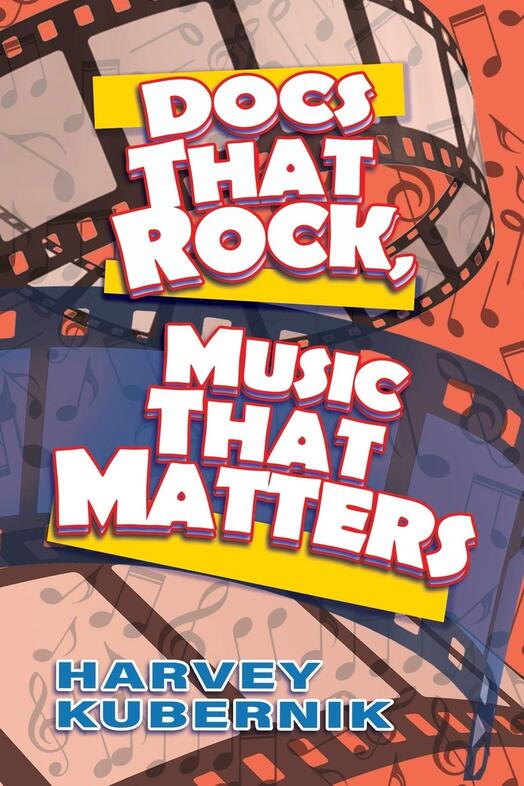
DOCS THAT ROCK, MUSIC THAT MATTERS by Harvey Kubernik (published by Otherworld Cottage Industries) Presenting a history and exploration of the music-documentary genre is an intriguing idea for a book. Of course, the difficulty involved in such an undertaking is the sheer amount of films that could be included … the list is already huge and continues to grow! At over 500 pages, this is a hefty volume but it concentrates on Harvey Kuberniks’ personal choice rather than attempting to cover everything. That being said, he includes an interesting and varied selection of films that cover many different styles and artists and doesn’t limit it strictly to documentaries, which certainly helps to maintain your interest. Early chapters include interviews with the legendary Dick Clark, producer of ‘American Bandstand’, before moving on to DA Pennebaker, the man behind the Bob Dylan film, ‘Don’t Look Back’ and the classic ‘Ziggy Stardust’ concert movie. Further chapters include insider stories from Elvis Presley’s ’68 Comeback’ show as well as lesser known documentaries such as ‘Rumble’, a film that told the story of Native Americans who made their mark on the rock’n’roll scene. The nature of music films and documentaries is such that the chronology seems to go back and forth, depending on when the films or shows were made, so it can get a little confusing at times but the subjects are usually fascinating even if they may not involve your particular favourites, artist-wise. There are some great insights into the Jimi Hendrix films, ‘All is By My Side’ and ‘Live at Monterey’, while the Rolling Stones are represented by chapters on ‘Rock’n’Roll Circus’, ‘Charlie is My Darling’ and ‘Gimme Shelter’. Elsewhere, the likes of The Doors, Motown, Bob Marley and The Johnny Cash Show are covered in depth, whilst a chapter is also devoted to Alan Arkush, the Ramones and ‘Rock’n’Roll High School’. More recent times are also covered with pieces on the eclectic soundtrack for Quentin Tarantino’s ‘Once Upon a Time in Hollywood’ (evidently a lot more interesting than the film itself…) and David Leaf’s acclaimed documentaries on John Lennon, Brian Wilson and James Brown. The final chapter is taken-up by an interview between Kubernik and publisher Travis Pike, whose career across five decades has also involved several music-related movies including ‘Feelin’ Good’ and the ongoing ‘Morningstone’ project. I have to admit, it’s a little difficult reviewing this book, because there are so many different subjects within the chapters and a lot will possibly depend on your own personal tastes, but there really is a lot here for any music fan who really wants to know more about the way things have developed over the years. This is certainly a book that will give you plenty to think about.
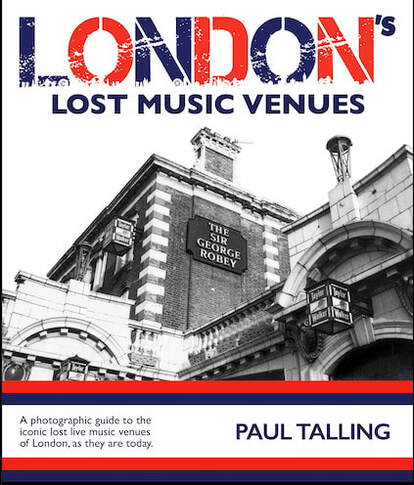
LONDON’S LOST MUSIC VENUES by Paul Talling (published by Damaged Goods) If you’ve ever been a regular gig-goer, you’re almost guaranteed to reach a point where you’ll begin to lament not only bands that are no longer around but also the venues that are no longer with us. Of course, this happens everywhere, but in London, with its’ insatiable appetite for property development (eg, building more and more insanely-priced flats for people who have no sense of community) it seems to be at its’ worst. Even places that have real claims to historic importance aren’t immune to this ugly process – the most celebrated location of the Marquee club in Wardour Street hosted everyone from The Who, Jimi Hendrix, Pink Floyd and David Bowie through to the Sex Pistols, AC/DC, Motorhead, Joy Division and The Cure, but when developers moved-in none of this history was even considered. What this book sets out to do is to commemorate important or, at the very least, enjoyable London venues that have been lost along the way. This volume concentrates on the smaller venues (pubs and clubs) whilst a second tome will look into the larger venues that have disappeared. Delving all the way back to the Fifties (although some of the actual buildings date back even further) we have venues like the 2i’s Coffee Bar in Old Compton Street which has a strong claim as the birthplace of British skiffle and rock’n’roll but is now a fish and chip shop. Across to Twickenham and there was the Eel Pie Island Hotel, which played an equally significant role in the Sixties. Bands who played here include the Rolling Stones, The Manish Boys (featuring a young David Bowie) and The Who. After the Hotel burned down in mysterious circumstances, the site eventually became an expensive housing development. On into the Seventies, The Roxy club in Covent Garden was an incredibly important part of the Punk and New Wave movement (it’s now a Speedo’s boutique) whilst The Vortex in Soho lasted between 1977-78, featuring bands such as Buzzcocks, The Fall, Siouxsie and the Banshees and even the likes of Boomtown Rats and Tubeway Army. At least the site of The Vortex is still intact, albeit now a trendy bar with no live music. Paul Talling has done a great job researching the details of all these venues, providing photo’s of how they were and how they are now wherever possible. His credentials as a former gig-promoter (strictly indie) also put him in a great position to add personal insight to the subject and while some of the stories are sad in a way, that London has lost so much of its’ recent cultural heritage, the tales are also absolutely fascinating. I’m sure you’ll start reliving some of your own gig-experiences as you read about familiar venues and you’ll also find many details and locations that you didn’t know before now. This is an essential book for anyone with a real passion for rock and pop music, who wants to get to know the roots of it. Get yourself a copy at the earliest opportunity!
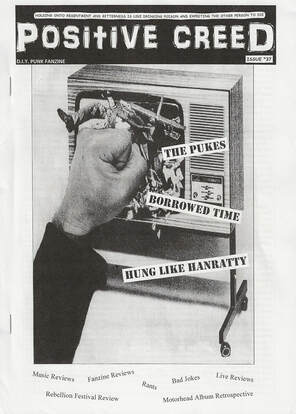
POSITIVE CREED # 37 ([email protected]) Based in Devon, what I like about this fanzine is that it covers what’s going on locally together with a broader view of other happenings in the Punk Rock world, and gets the balance just right. Obviously, you want to cover and encourage things that are going on in your own area, but too often zines get a bit too regional and as such, aren’t going to appeal to anyone from outside of the area. This issue includes The Pukes (a great example of a group of friends starting something pretty-much for themselves and then going on to become popular all over the country) Borrowed Time and Hung Like Hanratty (two more bands that are both playing wherever they can.) I think it’s the thing about Punk Rock – elitists can say that its’ best to keep it on a small, grassroots level but isn’t it just as important to get your ideas over to as many people as possible? Positive Creed is defiantly DIY and always makes an effort to include whatever Rob enjoys and feels that he has to share with others. That includes retrospective Motorhead articles, a whole page of terrible jokes and reviews of Rebellion Festival, some of which might not be your mug of scrumpy, but you can always enjoy the enthusiasm with which it’s written. Positive Creed appears on a pretty regular basis so there’s probably a few more issues since this one… time for you catch up!
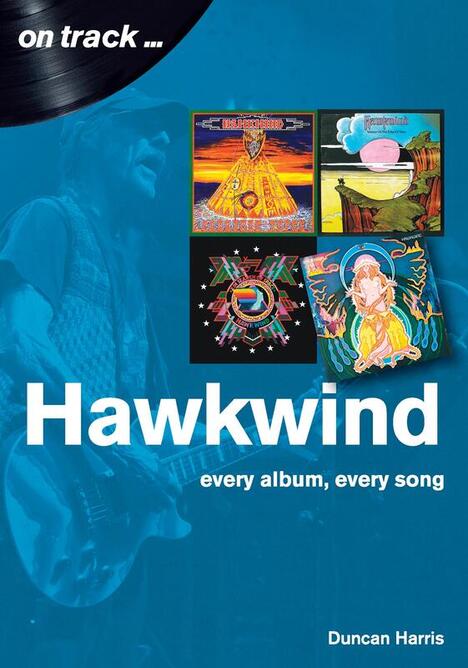
HAWKWIND – Every Album, Every Song by Duncan Harris (published by Sonic Bond.) Well, not every album, as the author explains, because in recent years there have been so many compilations of previously released material that covering those as well would be rather unnecessary. However, he does do his best to cover later albums that include new versions of earlier material, of which there are plenty in themselves… This book is particularly interesting as there’s such a large amount of Hawkwind albums that it’s pretty difficult to know where to start. Their very early music evolved from the busking style of several original members, but soon started to develop in a more psychedelic direction, influenced by the same West London scene in which the original Pink Floyd had flourished. Over the course of several albums, they developed a sound that became known as Space Rock and, with Lemmy providing his trademark bass-sound, were one of the few UK bands with a real claim to be a precursor to the Punk movement. At the same time, they also developed an elaborate light-show that would also influence the way that many rock bands would present themselves and pre-date the way that lights would be used as sensory-overload in the Rave scene. Up until the mid-Seventies, the core musicians remained in the line-up but thereafter there were many and frequent personnel changes until Dave Brock became the only consistent, original member. Much has been made of this, with critics often accusing Brock of being dictatorial within the band, but the author goes to some length to show this hasn’t been the case and, apart from various conflicts with original sax player Nick Turner, he has remained on good terms with most of the former members. But, back to the music itself… many will point to the albums produced between 1971-75 (including the awesome live recording ‘Space Ritual’) as their best. Certainly these were the albums that established them and, to a great extent, defined them, but as Duncan Harris points out, there are plenty of later records that also stand-out. The enthusiasm with which these albums are reviewed will encourage you you to check them out whilst, at the same time, the book also points out the ones that you really ought to avoid. As I said before, when there is so much material already available, it can be difficult to know where to begin your investigations, but this book sets out to point you in the right direction. Hawkwind have produced some truly great records over the past five decades and, with the help of this book, you’ll now have a good idea of which ones you need to hear.
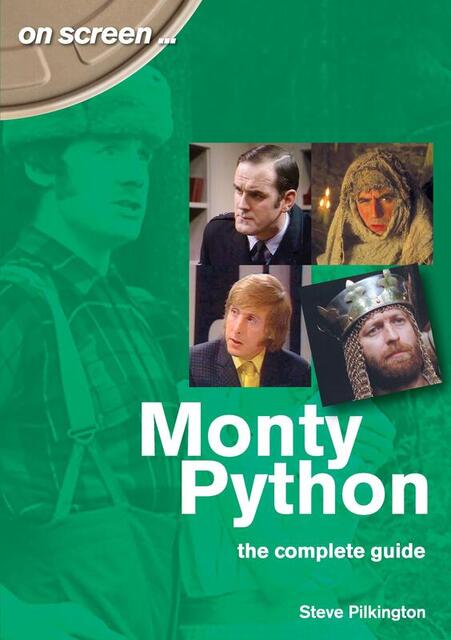
MONTY PYTHON – The Complete Guide by Steve Pilkington (published by Sonic Bond.) As the title says, this is a complete guide to every episode of the TV series, every film and even their record releases. There are very few that would try to deny the Pythons’ place in Comedy and Cultural history and, as such, there have already been plenty of books recounting their story. However, this one goes above and beyond the call of duty to present as many details and trivia as is reasonably possible. Now that in itself could backfire as there are plenty of Python ‘nerds’ out there who would revel in revealing uninteresting and probably pointless drivel about the show (which would have been just the sort of thing that Monty Python would have parodied back in the day…) But where this book works is that Steve Pilkington never loses touch with their sense of humour and doesn’t let his writing get tied down with the sort of facts that fans don’t really want or need to know. He analyses the individual episodes but always in a pretty balanced way, pointing you towards the jokes and sketches that still work the best (unfortunately, some of the older material has inevitably become more dated than other pieces.) He also effective draws attention to many of the lesser known, but still highly enjoyable, sketches. Everyone knows the famous ones, ‘Dead Parrot’, ‘Silly Walks’ and ‘The Lumberjack Song’, but equally as hilarious are ‘Minehead Bi-Election’, ‘The Bishop’ and ‘The Piranha Brothers’. If only to remind you of these gems, this book is well-worth the read, but it’s also interesting to hear the background stories and what was going on within the team whilst the shows were produced. The book takes a similar look at their full length films and the various albums that were compiled from the TV shows and movies (including the innovative packaging they produced for the records.) As I’ve already said, the book is well-balanced and Pilkington is never afraid to say when something falls-flat or doesn’t work, which gives more credibility to the pieces that he praises. If you want to go back and investigate the original Python output, this is an ideal guide that will put things in perspective and give you a very good idea of what material you can’t afford to miss.
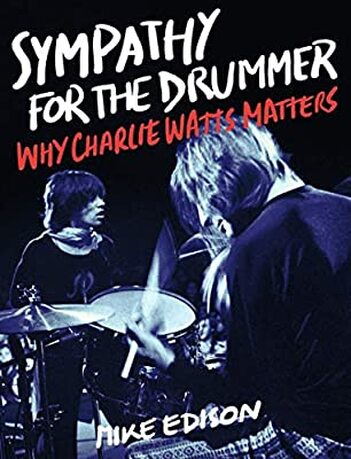
SYMPATHY FOR THE DRUMMER – WHY CHARLIE WATTS MATTERS by Mike Edison (published by Backbeat Books.) The title basically says it all ; this is a book dedicated to the quietest member of the Rolling Stones, explaining why his contribution to the band is just as essential as the more celebrated talents of Jagger and Richards. Of course, by this point in their ongoing career, I doubt if any fan hasn’t already reached the same conclusion. Charlie Watts came from a Jazz background before joining the Stones and has embraced the intricacies of that style, often adopting the ‘less-is-more’ approach to provide the perfect foundation for the rest of the band. With Jagger and Richards, the Stones effectively have two frontmen (and with Brian Jones, three) so Charlie has always had the task of providing a solid base to hold everything together whilst also allowing enough room for the others to flourish. It takes a real sense of focus as well as musical talent to achieve this properly and Charlie has nailed it for over 50 years. I doubt that anyone would disagree with this assertion, so in some ways this book isn’t a necessity, but it’s clearly something that Mike Edison wanted to document once and for all and he does so with a vibrant, sub-gonzo style that continuously reflects his enthusiasm. There are more than a few great rock’n’roll stories along the way to keep you amused, even if Charlie never reached the heights of debauchery in which his band-mates partook. So, although the book doesn’t really include any truly eye-opening moments, it still manages to make its’ point in an enjoyable and entertaining fashion. It’s probably only going to be of interest to established Stones’ fans, but if you’re one of them, then you’ll certainly want to read it.
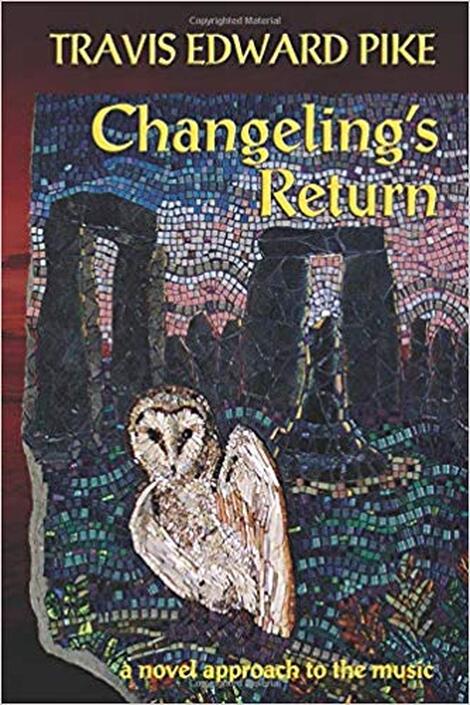
CHANGELING’S RETURN by Travis Edward Pike (published by Otherworld Cottage Industries.) Hopefully, you’ll already be familiar with Travis Pike (and if not, you can check out my interview with him, elsewhere on this very website.) Travis has been making music since the early Sixties and interest has been recently revived by the release of ‘Watch Out Woman’ / ‘The Way That I Need You’ (from the soundtrack of the movie ‘Feelin’ Good’) on State Records, plus a reissue of ‘If I Didn’t Love You Girl’ on Mousetrap Music. Later in his career, he became more involved in the film industry and began working on ‘Changeling’, initially as a rock-opera but eventually evolving into a screenplay, the text of which was published as a book in 2017 alongside a CD of music intended for the project. Although the screenplay generated interest, it’s not the best way to read a story, so Travis has now adapted the tale into a novel, which elaborates many of the themes and ideas from the screenplay and gives much more depth to the different characters. The novel tells the story of Morgen, a talented young rock singer whose career is on the verge of international success. However, a car accident leads to a mystical experience and he finds himself in the village of ‘Morningstone’ where he becomes acquainted with esoteric folklore and symbolism before returning to the ‘real’ world, where he is inspired to create a new album reflecting the awakening that he experienced. The novel goes on to tell how he perseveres to fulfil his destiny, despite objections from his record company bosses and those that are unwilling to accept his vision. It’s a great story and it includes a lot of almost-paganistic values relating to mans’ relationship with nature and the need for a balance to be reached before mankinds’ greed and supposed ‘progress’ damages the world beyond repair. In so many ways, it’s a message that is even more important now than when Travis initially began work on this project. Morgen is an intriguing character, not without his flaws but strong enough to be more than believable. I’m sure that, if this story ever makes it to film, Morgen could certainly inspire a great performance! The only criticism I have to mention is that the text is sometimes overloaded with too many technicalities and details, which can disrupt the flow of the story… I have a feeling that Travis, whose background is more as a screenwriter rather than a novelist, wrote this with stage-directions in mind, but it’s not a terrible fault and certainly doesn’t distract from the story itself. In addition to the novel, Travis has also released a new CD of updated songs from the original ‘Morningstone’ project, including several new tracks. I’ll be including a separate review over in the record reviews section, so you can check that out now, but I will say that the CD gives a good indication of the musical ideas that are an integral part of the novel. If you can hear the album in conjunction with reading the novel, it certainly adds further depth. I'm more than happy to recommend this book, both for the fact that it’s a great read that delivers plenty to think about, but also for Travis’ exuberant enthusiasm which, if you follow his work, is nothing less than infectious. I’m so glad that this guy is still out there and sharing his creative energy!
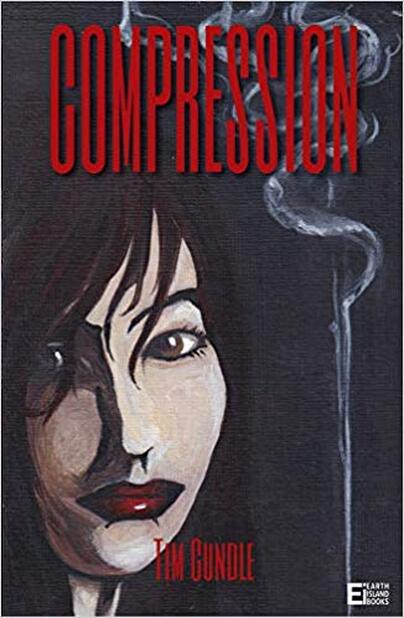
COMPRESSION by Tim Cundle (published by Earth Island Books.) This is the debut novel from Tim Cundle, who has previously sung in hardcore bands and also written for various magazines. Without having any real idea of what I was going to get, I found myself really enjoying this tale and, although there are some points that could have been better-realised, for the most part this is also very well written. Presented in the first-person, the story tells of Flanagan, a successful musician who returns to his hometown for the first time in a decade (and the first time since his success) to confront former friends, unresolved relationships and also the shadow of a murder committed by his manipulative associate, Eliot. The band and the hometown are never actually named, which allows for your own imaginative input and also puts more spotlight on the characters and the dilemmas they try to resolve. with flashbacks revealing details of the background, and it comes together at a pretty natural, authentic pace. I won’t give away too much of the actual plot as that would possibly spoil your enjoyment, but Flanagan’s world is effectively turned around as the events unfold. Previous obsessions are revealed as worthless when viewed in reality, whilst loyalties show themselves in their true colours, both positive and negative. There are some characters and elements that aren’t as strong as they could have been, but for a debut novel that’s not exactly a sin. In some ways, the theme of returning to a former home is reminiscent of certain novels by Iain Banks and, in similar style, the story-telling is always the important factor. In addition, the book comes with numerous striking images which help to accentuate the events. I will certainly be interested to read further novels from this writer and have no problems recommending it to anyone who enjoys novels that are both entertaining and intriguing.
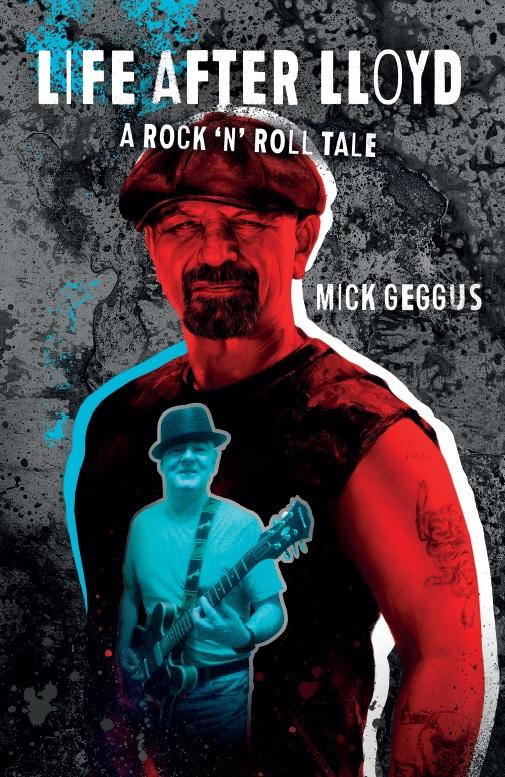
LIFE AFTER LLOYD – A ROCK’N’ROLL TALE by Mick Geggus (Cadiz Music) This is the second volume of Cockney Rejects memoirs, following Jeff Turners’ biography, published back in 2005. But rather than reiterating the same stories, Mick takes it upon himself to narrate the tale of Tony Van Frater, the bands’ bass-player from 1999 until his untimely death in 2015. Obviously a major part of the band and their music during those years, his loss almost signalled the end of the Rejects, although retrospect would eventually give them the space to realise that continuing the band was a much more worthy tribute to their departed-friend than throwing-in-the-towel. They had an obvious replacement available in the shape of original bassist Vince Riordan so, rather than go through the hassles of finding someone entirely new, they were able to keep things within the Rejects family. The loss of Tony (affectionately known to Mick as ‘Lloyd’… you’ll have to get the book to find the full details) had affected Mick and his brother in very different ways, but reading Mick’s account of how they came to their decision to carry-on is surprisingly open and it would only be a heartless cynic who was unable to empathise with what the band went through. It may surprise some people that Mick is able to put his feelings and emotions into words so effectively and you can only respect him for his honesty. However, although this particular episode is the key to the whole book, it’s not the only subject and there are plenty of stories that tell of the bands’ humour and hardships. Just as much of the book is dedicated to the fun they had together and how they managed to return to full-strength despite their loss. Many of the stories concerning Tony are ridiculously funny, just as rock’n’roll stories ought to be. The Rejects certainly seem to attract those kind of situations more than most bands... I won’t recount any specifics, because you really need to read the book for yourself, but trust me, there are tales in here that will have you laughing out loud. Mick has a real talent for recounting stories like they’re and obviously the things that he still enjoys within the band. Even when he’s revealing the problems that they’ve had with various dodgy promoters in America, something that’s caused them a lot of stress, he does so in an almost tragic-comedic way that keeps you entertained even while you feel sympathy for what they’ve endured. This isn’t a particularly long book, but it covers so much that hadn’t even happened when Jeff’s book was completed that it stands up in its’ own right and is every bit as vital. As Mick points out, he and his brother are very close and yet very different people. When you read this book you get an idea of the other side of the Cockney Rejects character. The book will mainly be appealing to existing fans, but it’ll also be of interest to anyone who wants to know what the band is all about. It’s honest and at times it’s a sad story, but there’s also a lot of fun, making this a story that’s will be well-worth your time. All I can say is that you really ought to do your best to read this book.
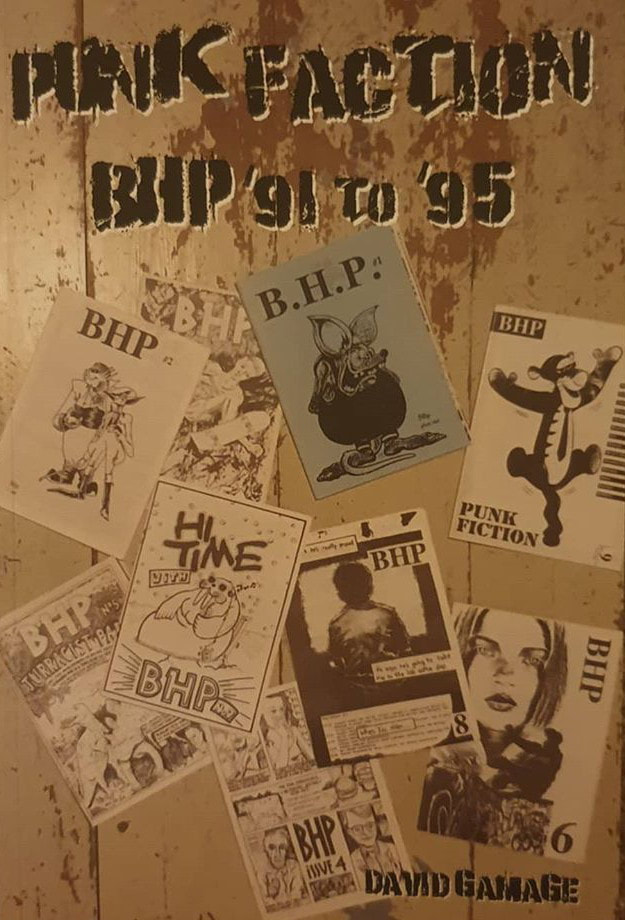
PUNK FACTION – BHP ’91 to ’95 by David Gamage (Earth Island Books) The first time I was in touch with David was sometime in the late Eighties. He’d either sent a demo of one of his bands for a review or perhaps he came to one of the gigs we were (badly) organising in Canterbury. Anyway, he was living in Tunbridge Wells, which wasn’t too far away, and also going to a lot of the same gigs up in London, so it was inevitable that our paths would cross. He was in several bands, most notably Couch Potatoes and Joeyfat, the latter of which I saw live on quite a few occasions. He also ran his own fanzine, ‘BHP’ (generally understood to stand for ‘British Hardcore Press’ although there were other explanations…) and its’ those publications which form this book. Now, I can’t say it was the best fanzine ever made (and I wouldn’t say it about ‘Fear & Loathing’ either) but ‘BHP’ really captured the essence of what fanzines are supposed to do, namely, to document a particular time, place or scene. The period when ‘BHP’ started was at a point when ‘alternative’ music was still very much underground, just before Nirvana hit the national charts and several years before Greenday became huge (in fact, Greenday feature in a couple of brief interviews included in this book, before the release of ‘Dookie’ and while they were still playing small venues…) Back at the time, interviews were mostly organised by turning up early at gigs and asking the bands if they could spare some time (very few would ever turn you down) or, if you wanted to be a bit more ambitious, sending a bunch of questions in an envelope and hoping you got a reply (The internet has since made things easier, but somehow less exciting…) When you read through this book, it recalls so many quirks of that time… the music was always the important thing but at the same time, fanzines like BHP would cover subjects like Vegetarianism, Hunt Saboteurs and Factory farming, all things which were still pretty underground subjects. It’s also interesting to see how things develop, from covering smaller bands who were totally DIY just because you liked them, through to being asked to feature bands like Garbage, who were basically manufactured to become instantly-popular. On that occasion, the offer of free food and drinks won-over, but generally David and his trusty-contributors stuck to things that they knew and loved, doing their best to let other people know what was going on. Also, as our musical tastes were pretty similar, there’s loads of reviews of gigs I attended and records that I bought, so it’s great to read what someone else made of them. Similarly, if you’ve ever been in a band and you read Davids’ account of the Couch Potatoes tour through Germany, you’re going to recognise at least a few of the situations. I think it’s that aspect of familiarity which I most enjoyed. The writing is in a very down-to-earth style and if you were around at the time, you’re going to identify with it. At a time when the history of Punk Rock seems to get re-written on a monthly basis (often by people who weren’t even there) a book like this is an essential document of how it continued to develop, what was really happening and how much fun it was… And, of course, it continues. David now runs the excellent Engineer Records label and continues to play music as guitarist in the band, Come The Spring.) This document is the real thing and whenever someone tries to tell you that Punk died by 1979, you can shove this down their throat ! Highly recommended.

SAFETY PIN #4. (www.safetypinmag.com) I’ve been very impressed by the rapid publications of these mags. The first issue surfaced only last year and, considering the colourful and glossy quality involved, it’s impressive that they’re up to #4 already. The main force behind it, Martin, has been involved with fanzines for many years and also works at People for Print (a well-known alternative printers based in Sheffield) so he obviously knows what he’s doing. But it’s the content that really seals the deal. The mag covers bands from many different aspects of ‘punk rock’, both old and new and from well-known through to grass-roots. The interviews tend to be well-informed and interesting even if you’re not a particular fan of the subject and that, for me, is what interviews should be about. Find out the reasons why people are doing what they do (of course, some bands have a lot less thought behind what they’re doing, but at least it’s good to know that’s the case…) The latest issue features Charlie Harper, The Lurkers (the Stride/Esso/Moore version) and The Svetlanas, who all make great reads. Lesser known bands like Chaos 8, Pizzatramp, Bones Park Rider and Hung Like Hanratty are also investigated and, in true zine tradition, there’s also plenty of reviews and articles which will, at the very least, have your noses twitching with curiosity. But it doesn’t even stop there ! The first issue came with a 7” vinyl EP by original Sheffield punkers The Stunt Kites, and since then each issue has included a free CD highlighting some of the best and most enthusiastic punk rock labels around (Damaged Goods, TNS and STP, to be precise.) The price may be a fiver, but you certainly get good value for your money and this is just the kind of thing that a vibrant scene needs. If you’re quick, back issues are still available from the website (see above) but regardless of where you start, be sure to check this out and support it as much as you can.
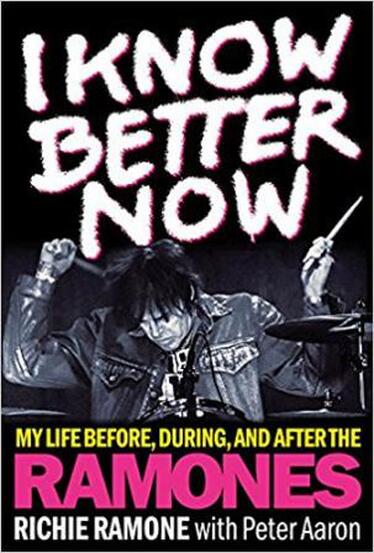
I KNOW BETTER NOW by Richie Ramone (published by Backbeat Books) I’ve always been of the opinion that Richie joined the Ramones at a crucial point in the bands’ history. By 1982, their two most recent albums, ‘Pleasant Dreams’ and ‘Subterranean Jungle’ had both included classic songs but had failed to meet commercial success. Drummer Marky had developed an alcohol problem that facilitated his being fired and the relationships between Joey, Johnny and Dee Dee were as volatile as ever. The band could quite easily have imploded but, instead, they recruited Richie from the ensuing auditions and what he brought to the band would establish them for the remainder of their career. He was a talented drummer who could provide the perfect backbeat for the band whilst also contributing back-up vocals and offering his own song-writing abilities. On top of this, his enthusiasm towards the band re-sparked their overall approach and, in 1984, would result in the rightly-revered ‘Too Tough To Die’ album which revitalised their reputation. Over the following years he would contribute great songs like ‘Somebody Put Something in my Drink’, ‘Smash You’ and ‘Can’t Say Anything Nice’ to the setlist and certainly established himself with the fans, even though the original band members (particularly Johnny) seemingly failed to fully recognise his contribution. He eventually quit the band in 1987 after a disagreement over merchandise-rights, but by that point he had already played a pivotal part in establishing the bands’ reputation which would see them become global legends before their eventual demise in 1996. What this book explains is that their story isn’t as simple as most biographies try to relate and that the mid-Eighties period was just as essential to their legacy as their original Seventies output. But, just as a biography ought to do, it tells the whole story of the subject, with tales from his childhood, his original obsession with drumming and his musical career both prior and after the Ramones. He also discusses his regrets concerning his departure from the band and particularly his estrangement from Joey, with whom he had become a close friend. The book is written very well and without any sense of bitterness or spite, even though his contribution has often been ignored or understated. Even though there have already been numerous books about the Ramones, for anyone truly interested in the band, this is an essential piece of the puzzle and one that you can’t afford to miss.
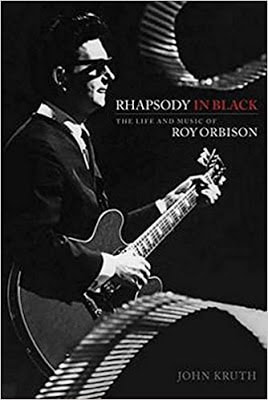
RHAPSODY IN BLACK ; THE LIFE AND MUSIC OF ROY ORBISON by John Kruth (published by Backbeat Books) Although most-remembered for hits like ‘Oh Pretty Woman’, ‘Only the Lonely’ and ‘It’s Over’, many people forget that he was also one of the original rock’n’roll stars at Sun Records in 1956, where he recorded classics like ‘Ooby Dooby’, ‘Go! Go! Go!’ and ‘A Cat Called Domino’ (later covered by The Cramps.) But while he moved away from the rockabilly sound when he signed to Monument Records in 1960, he was by then developing his vocal prowess and a distinct lyrical approach which would soon set him apart from any other singer of his time, leading to his biggest successes. Despite adopting an almost anonymous persona (permanently hidden behind his dark-shades) Orbison had an incredible voice that made its’ own mark, while his songs spoke of vulnerability and loss. Combined with the innovative production skills of Fred Foster, they created a pop sound that was epic and just as emotive as the words themselves, providing early-inspiration for the likes of Phil Spector and others. What this book does is not only document the recordings and the way that they came about, but also tells the story of the man himself and the tragedies that he had to bear whilst creating his music. This is the part not many know, but it is a story in itself. Orbison and his first wife, Claudette, had divorced in 1964, only to re-marry a year later after reconciliation. However, this tragically cut-short when she died in a motorcycle accident in 1966. Two years later, whilst he was on tour in the UK, a house fire cost the lives of his two eldest children, further devastating his family. At the same time, his music had fallen from favour, due both to managerial problems and the dominance of new artists like the Rolling Stones and The Doors (even despite The Beatles being notable fans of The Big O !) During the Seventies, he continued to tour but had little chart success and it was not until 1986 when his song ‘In Dreams’ featured in David Lynch’s movie ‘Wild At Heart’ that he started to develop a new audience. He collaborated with artists like k.d.lang, Tom Waits and Glenn Danzig (!) and was inducted into the Rock’n’Roll Hall of fame by Bruce Springsteen. In 1988, he would also collaborate with George Harrison, Bob Dylan, Jeff Lynne and Tom Petty as The Travelling Wilburys, taking him back to the top of the charts. However, fate still had one more nasty trick in store for him. He suffered a heart attack and died, aged only 52, at the end of that same year. Reading this book, you’re able to put everything in context and appreciate the life and career of this man and it really is an incredible story. At the time of his death, his career had been completely revitalized and he really was a living-legend. If he had survived longer, there’s a good chance that we would have heard more great music from him, but as that was not to be the case, we can still be content with all the classics he had already left for us.
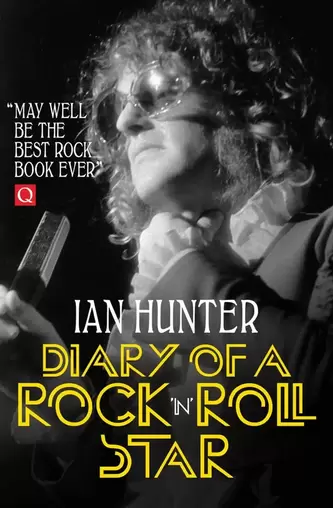
DIARY OF A ROCK’N’ROLL STAR by Ian Hunter (published by Omnibus Press) I’ve often read comments in the music press rating this book as one of, if not the best rock’n’roll tomes ever written. Of course, that kind of hype can be off-putting, especially when the same kind of magazine also sings the praises of Led Zeppelin or Guns & Roses, but when trusted friends tell me the same thing, I know that it may well be true. Unfortunately, having never been the biggest Mott The Hoople fan, I’d never gone out of my way to investigate further. But having finally caught up, I am now kicking myself. I have no excuses – I have failed in a task that I should have completed a long time ago. This is, indeed, a wonderful book. I won’t say it’s the best rock’n’roll book I’ve ever read, but it’s very near the top of the list and it’s certainly influenced many of the great books that have been written in subsequent years. The key to the success of this book is Ian Hunters’ complete lack of ego or pretension. Despite the title (one not chosen by Hunter and something he has never been comfortable with) the whole narrative is down-to-earth and completely devoid of bullshit. Mott The Hoople may have been pretty-well known at the time, but were far from mega-stardom and still spending their time finding ways to supplement their wages (in their case, scouring local pawn shops in the towns they played for vintage guitars that they could sell at a profit when they returned to London !) Based around their 1972 American tour, they encounter plenty of problems but confront them with anger, bewilderment and humour, depending on the severity. The difficulties and reactions really aren’t that far removed from how we all respond to every-day life, and that’s the beauty of this book. We’re not in the same situation, but emotionally, we all know the same feelings. Equally, the genuine passion that’s related when things go their way, we all know that ! Forty five years after the event, a book like this could easily become a mere period-piece, but that simply isn’t the case here. It remains such an easily-relatable tale, even if you’re not a fan of the band. Or even if you’ve never heard of them. The story is about real people with real lives in the real world, even as legends like Bowie, Iggy Pop and even Elvis Presley grace the pages. Isn’t that what great literature is about ? Or great music, for that matter… This is a very enjoyable book for all the right reasons and, even if it isn’t entirely about Mott The Hoople, it will give you a much better appreciation of what they were about and why so many people still rate them so highly. But it’s the book that really counts and all I can say is, don’t make the same mistake I made. Be sure to read this as soon as you get the chance.
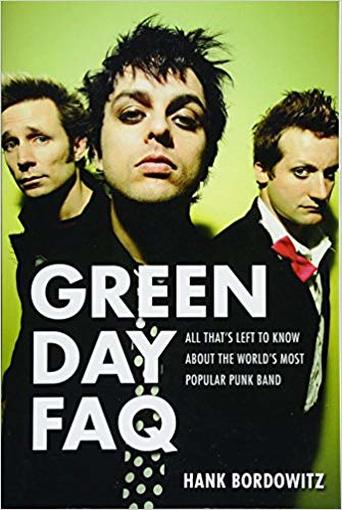
GREEN DAY FAQ by Hank Bordowitz (published by Backbeat Books) I saw and interviewed Green Day during their early tours, before ‘Dookie’ went massive, and I’ve also seen them in recent years, headlining big events at Hyde Park (even if I was mainly there for some of the support bands.) I’ve never thought that they ‘sold-out’ or ‘copped-out’ for the simple reason that, I always thought they were a ‘pop’ band so what’s the problem with them getting popular ? In fact, if anything, they’ve actually become more political as they’ve become more successful, using their platform to speak out against American imperialism and right-wing trends. It’s not as if they were Crass playing a Royal Command Performance (although, I would love to have seen that !) so I have no problem with Green Day even if I haven’t bought any of their records for a long time. I still think they’re much more a positive than a negative. Joe Strummer is quoted here, saying, ‘When Green Day come out of my radio… it sounds a lot better than the rest of the shit coming out of it’, and basically that’s the crux of the matter. Are you going to dislike a band just because they’re popular ? What this book does is to lay out all the information you want or don’t want to know. To be honest, at times it delves into areas that I would rather not read about (not that I’d prefer to not know about it, but just that it’s dull) and the whole business side of things doesn’t really interest me. There are more important details that I would have preferred to see documented (it refers to the bands’ performance on the American Music awards when they encouraged the audience to chant ‘No Trump, No KKK, No Fascist USA’, but doesn’t accredit MDC for the original lyric, even though Green Day did so in several high-profile interviews.) On several occasions, the author seems intent on excusing Green Day for their popularity when that seems to miss the point… For me, they don’t need to explain themselves, we ought to be big enough to figure these things out for ourselves. It’s okay to like things that you enjoy… would you employ the same criteria to Elvis Presley ? The Beatles ? The Sex Pistols? Where this book does work – and it does so very well – is that it documents a band who came from a genuine DIY, punk rock scene and with no musical compromise or coercion, crossed over to the mainstream. Even Lawrence Livermore (founder of Lookout Records) acknowledges this and he was there from their very beginning. Green Day have become massively popular but they still write and play good music and have a conscience (although hanging-out with Bono is pretty sick.) If a band is going to be successful, isn’t this a better game-plan than Oasis ?
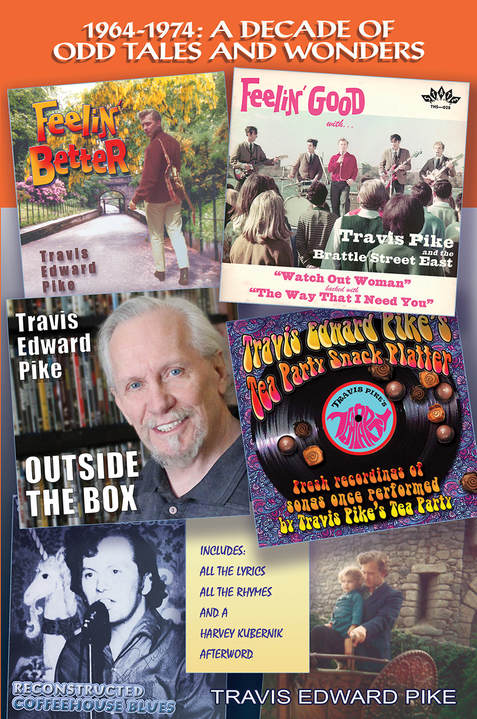
1964-74 : A DECADE OF ODD TALES AND WONDERS by Travis Pike (published by Otherworld Cottage Industries.): This book was originally published in 2013 and has been one of the cornerstones (alongside various reissues and compilations of new recordings) in the resurgence of interest in Pike’s musical and artistic career. To build on this and to ensure that the story remains in the public domain, a newly expanded edition of his book is now being made available and I hope that it brings his story to an even wider audience. He may not be the best known name from the Beat music era of the Sixties, but his tale is unique, intriguing and very well-told. Travis not only has a great story to tell, but he knows how to make it entertaining. A series of misfortunes conspired to prevent him from achieving the success that in other circumstances could easily have been his, but he still remains remarkably positive about his experiences, preferring to share and enjoy what he did achieve rather than bemoaning what might have been. His enthusiasm is infectious, really drawing you into his adventures, from Hot Rods and Demolition Derby’s in Boston through to time spent in Germany as a US Navy recruit, spending his free-time as a popular rock’n’roll singer in the nightclubs. Eventually back in the States, his musical career starts to take off, finding himself staring in the cult-movie ‘Feelin’ Good’ before forming his bands The Boston Massacre and, subsequently, The Tea Party. They relocate from the East Coast to Los Angeles in an attempt to further their ambitions, but like many other notables, they weren’t destined to become household names. But this is never the point of this tale, it’s the fact that they took their dreams and ran with them. If that isn’t an inspiring tale of rock’n’roll in its’ true essence, what is ? This new edition includes over 100 extra pages of new text and additional photographs (fortunately, Travis has always maintained a healthy archive.) In the five years since the book was first published, he has been able to reassess the original narrative and now recounts it even more effectively. It’s a pertinent reminder that the history of rock’n’roll certainly isn’t just about the big names ; it’s the grass-roots that keep everything going ! I wholeheartedly recommend this book to anyone with a real interest in Beat music and great stories !
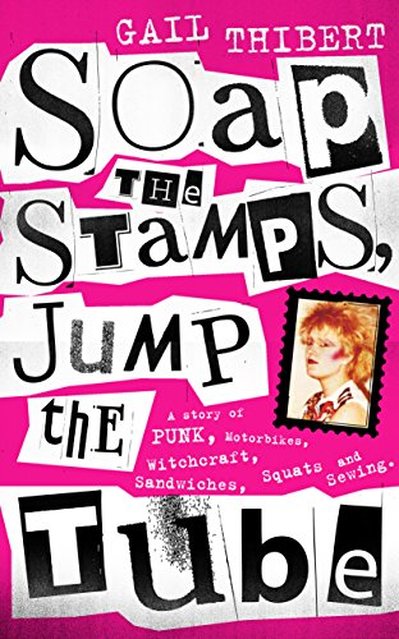
SOAP THE STAMPS, JUMP THE TUBES by Gail Thibert (published by www.unbound.com) Gail has led an illustrious punk rock life, attending gigs since the early Eighties and playing in bands such as Adventures in Colour and Lost Cherrees. She also balanced these escapades alongside numerous precarious day-jobs (some a lot more interesting than others) and an equally unpredictable decade of living within Londons’ then-flourishing squat-scene (before eventually moving-up to Housing Association tenancies.) She recounts this period in her life and intersperses it with tales of motorbikes, travels to Greek islands and relationships both good and bad. Her story takes so many twists and turns that it never becomes tedious or self-indulgent, with events from funny to sad and words of wisdom standing alongside words of warning. But for me, the most intriguing aspect is the way that so many points in Gails’ life have overlapped with my own, albeit several decades before I actually met her. She talks about gigs that I attended, places that I went to and friends that I also knew. It turns out that she was even living at a squat that I occasionally stayed at, if I missed my last train back to Kent. I suspect that this is going to be the case for many people who were part of the London punk scene at that time, so for them it’ll be a great series of flashbacks. At the same time, though, for those who weren’t there, it’s also a great document of an era when, despite the one-sided prosperity of Thatchers’ society, a vibrant alternative existed on a much-less financially-obsessed level. Admittedly, as Gail illustrates, there were a lot of unpleasant aspects to all of it, but she still portrays it as a positive time for those determined not to take part in the Capitalist circus. Gails’ writing is remarkably confident for someone writing her first book and my only criticism is that I would have liked to see photos or artwork to illustrate the era, but that takes nothing away from the story. I thoroughly enjoyed this book and I hope that this proves to be just the first of such books still to come from other sources.
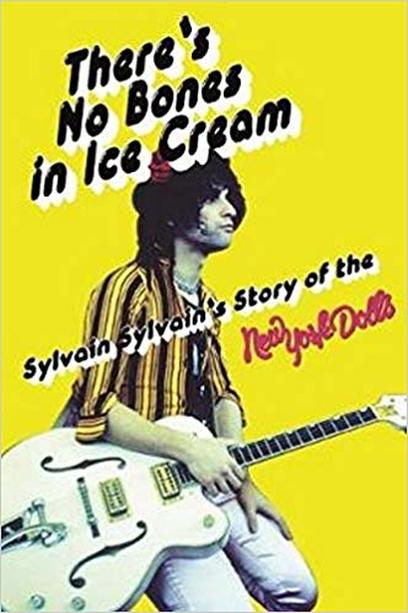
THERE’S NO BONES IN ICE CREAM by Sylvain Sylvain (published by Omnibus Press.) I have suspected for a long time that the most reliable and well-balanced account of the New York Dolls story would only appear if Sylvain got around to writing his autobiography. This book confirms my assertion but also offers more than I ever expected. To begin with, it’s over 100 pages before the band actually come together. In that time, Sylvain explains his unsettled upbringing (born to a Jewish family, living in Egypt, who were eventually forced to leave their home and seek refuge in France) and his eventual relocation to America, where his involvement in underground music, Art and fashion is almost inevitable. It sets the scene perfectly for when the group of friends (rather than musicians) come together to form their trail-blazing band. I expect most of the ensuing tale is probably already familiar to fans, but in these pages you’ll discover more relevant details than ever-before, from the highs to the tragic lows. The important theme that keeps the story so insistent is that, throughout the whole story, Sylvain maintains such a positive approach. For a member of a band who never achieved the recognition and success they deserved (only to see countless others blatantly ‘borrow’ their style and sound to gain massive popularity and sales) Sylvain nonetheless remains resilient ; after all, he was an integral part of the Dolls. All the pretenders, however good they may be in their own right, all owe him/them their due. The fact that the mainstream never caught up is the fault of the mainstream and Sylvain comes across as content that what the New York Dolls achieved and attained can never be taken away from them. Perhaps it isn’t quite as outrageous now as it once was, but the songs still stand and sound great. For that, Sylvain is rightfully proud and, despite the trials they endured, no-one can take away their rightful place in rock’n’roll history away. It’s that attitude that makes his telling of the story so essential and enthralling. Admittedly, there are a few things that I would have liked to be covered in more depth (his post-Dolls’ musical exploits and more details about the eventual reunion alongside Arthur Kane and David Johansen) and I guess that was too much to ask for at present – perhaps it will surface at a later date ? But trust me, this is a book that you have to read. Hear the story direct from someone who was in the thick of it and who knows how to tell the story in an entertaining, positive fashion. There have already been some great books about the Dolls already, but I can’t imagine any ever surpassing this.
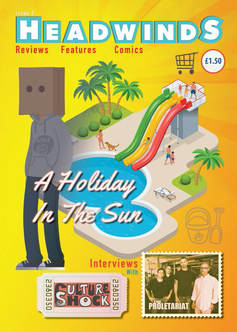
HEADWINDS #2. ([email protected]) Very well-produced (as opposed to the usual, shoddy FNL efforts) fanzine that combines music related interviews and articles alongside punk-themed comics/cartoons. Lots of record reviews and you get the impression these are recordings that the reviewer has actually bought rather than just receiving through the post - there’s a lot of obvious love for the music. The interviews (with Culture Shock and The Proletariat) are well-thought out, making them interesting for readers even if you’re not a fan or know little about the band, which is always a good thing (maybe you’ll pay more attention now that you know more about them.) At only 24 pages, it is a bit skinny (very popular amongst ‘the kids’, no doubt) and I do kind of wish there was a bit more material, but for a new publication, this is very promising and I’m really hoping for great things from it. The £1.50 cover price is well-worth the investment, so don’t be stingey – order a copy soonest !
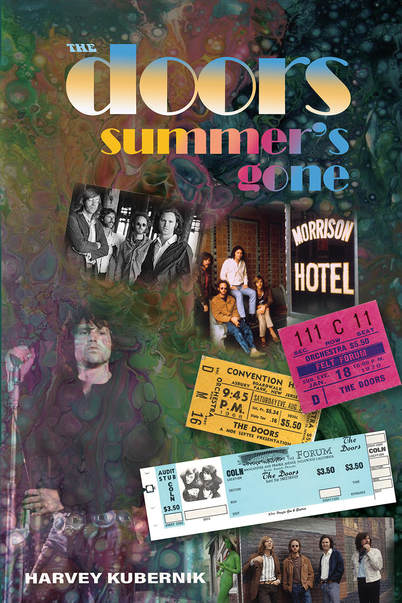
THE DOORS – SUMMER’S GONE by Harvey Kubernik (published by Otherworld Cottage Industries.) I won’t claim to be the world’s biggest Doors fan but it would be a fool who tried to dismiss them out of hand. Their legacy still remains untouched, a band who brought true innovation to their music, inspiring many others who would follow and truly epitomizing the late Sixties, West Coast rock scene of which they were the vanguard. Admittedly, familiarity with their ‘classic’ songs over the years has perhaps dissipated their original impact, but just listen to the original six albums (made in a mere four years !) and you’ll see how remarkable they were. In a way, the music is all you need to know and many of the books that have been published on the subject are almost unnecessary once you know the basic story, but this book really captured my imagination. Instead of just recounting the same old stories, facts and figures, Harvey Kubernik has opted to gather together rare or exclusive interviews and recollections with people who were there at the time, ranging from the band members themselves to original fans and acquaintances, to relate the memories that really capture what made it special for them. This is what makes the book so interesting, as it puts the story in a clearer perspective and makes it much easier to relate to. Fans – many of them just kids at the time – tell how they first came across the band and embraced their sound and image, while Ray
Manzarek, Rob Krieger and John Densmore explain how everything came together in a natural, unpretentious way. Their conversations relay the excitement they felt as their music was created (‘without ego’) in the same way that the fans relate their excitement in seeing the band for the first time. This is something that most, if not all of us can recognise, concerning whatever bands you’ve loved or have been in, and it’s that excitement that still makes rock’n’roll so vital. It made me grab my old Doors albums and spend an evening listening through them again ! Of course, much is made of the character and enigma of Jim Morrison and that’s inevitable. Someone who was such an iconic performer, who easily bewitched his audience but at the same time harbored a real desire to challenge them and push them further, is always going to be a focal point. But here, he’s also revealed to be a genuinely cool guy to those he got to know and someone who also felt the excitement of seeing his work come together (a particularly poignant tale comes from the bands’ former minder, Tony Funches, who relates the day when the first batch of Morrisons’ poetry book ‘The Lords and the New Creatures’ arrived… Jim is described both as being ‘excited’ but also ‘real shy…trying to hide how proud he was.’ ) It’s these recollections, rather than the tales of his eventual disillusion and decline which so many books have focused-on, which will appeal to the real fans, a real glimpse of Morrison and not the media-projection that is usually portrayed. It’s episodes like this, which capture the real essence of the band, that I enjoyed so much and I’m sure anyone else, from rabid fan to appreciative listener, will do the same. I’m hoping this book will have a thorough distribution around the world, but if you have any difficulty finding it, just look up ; www.otherworldcottageindustries.com
Manzarek, Rob Krieger and John Densmore explain how everything came together in a natural, unpretentious way. Their conversations relay the excitement they felt as their music was created (‘without ego’) in the same way that the fans relate their excitement in seeing the band for the first time. This is something that most, if not all of us can recognise, concerning whatever bands you’ve loved or have been in, and it’s that excitement that still makes rock’n’roll so vital. It made me grab my old Doors albums and spend an evening listening through them again ! Of course, much is made of the character and enigma of Jim Morrison and that’s inevitable. Someone who was such an iconic performer, who easily bewitched his audience but at the same time harbored a real desire to challenge them and push them further, is always going to be a focal point. But here, he’s also revealed to be a genuinely cool guy to those he got to know and someone who also felt the excitement of seeing his work come together (a particularly poignant tale comes from the bands’ former minder, Tony Funches, who relates the day when the first batch of Morrisons’ poetry book ‘The Lords and the New Creatures’ arrived… Jim is described both as being ‘excited’ but also ‘real shy…trying to hide how proud he was.’ ) It’s these recollections, rather than the tales of his eventual disillusion and decline which so many books have focused-on, which will appeal to the real fans, a real glimpse of Morrison and not the media-projection that is usually portrayed. It’s episodes like this, which capture the real essence of the band, that I enjoyed so much and I’m sure anyone else, from rabid fan to appreciative listener, will do the same. I’m hoping this book will have a thorough distribution around the world, but if you have any difficulty finding it, just look up ; www.otherworldcottageindustries.com

THE SEX PISTOLS 1977 : THE BOLLOCKS DIARIES, AS TOLD BY THE SEX PISTOLS (published by Cassell Illustrated.) Although the full story of the Sex Pistols extends much further than just this one year, it’s undeniable that 1977 was the period during which they made their most immediate impression, both on social and cultural levels. Whilst many original fans will argue, with some justification, that the real power of the band (and even ‘punk’ itself) was over by the end of 1976, it wasn’t until the following year that many people actually found out about the new movement. The band had been playing in London on a pretty regular basis, but if you lived further afield your chances of seeing them were slim even if you had heard about them or read reviews. So it wasn’t until 1977 when their records started to become available that most potential fans were able to hear exactly what the band were doing. Of course, at the same time the media coverage grew to frantic proportions, with tabloids blatantly fabricating headlines and whipping up bigotry along the way. But access to the music itself made the greatest impact. People were able to find out for themselves what the band sounded like and what they were singing about. Those who kept their eyes and ears open and who chose to think for themselves could appreciate the reality. The establishment did their best to contain this. ‘God Save The Queen’ was virtually banned and cheated out of its’ Number One spot (and remember, this was purely for political reasons ; there was no offensive language in the song, just opinions that the establishment didn’t want to have heard.) And later in the year, a Court prosecution attempted to criminalise the use of the word ‘Bollocks’. The bully boy tactic failed with a verdict that effectively vindicated the use of everyday language on a cultural level (something that we now take for granted.)
Of course, the pressure on the band themselves was immense and, indeed, they barely lasted to the end of the year. But whatever the eventual outcome, their impact had been made and can now be seen to be on a cultural level on par with that of Elvis Presley or The Beatles.
What this book succeeds in doing, is telling the entire story of that tumultuous year, with a verbal history recounted by members of the band and others who were there at the time. Illustrated with original photographs, documents and memorabilia, this book replicates the full story in superb quality. There are no attempts to interpret or analyse the events or material, but rather just an accurate account of what really happened. Putting it into this context will give the reader a good feel for what the band went through and how they changed the subsequent course of music, fashion and other forms of expression. While this particular publication may have been tied-in with the 40th Anniversary of the original events, the story it tells will remain relevant whenever you read it. It’s a beautiful book which gives a fine account of events which remain significant.
Of course, the pressure on the band themselves was immense and, indeed, they barely lasted to the end of the year. But whatever the eventual outcome, their impact had been made and can now be seen to be on a cultural level on par with that of Elvis Presley or The Beatles.
What this book succeeds in doing, is telling the entire story of that tumultuous year, with a verbal history recounted by members of the band and others who were there at the time. Illustrated with original photographs, documents and memorabilia, this book replicates the full story in superb quality. There are no attempts to interpret or analyse the events or material, but rather just an accurate account of what really happened. Putting it into this context will give the reader a good feel for what the band went through and how they changed the subsequent course of music, fashion and other forms of expression. While this particular publication may have been tied-in with the 40th Anniversary of the original events, the story it tells will remain relevant whenever you read it. It’s a beautiful book which gives a fine account of events which remain significant.
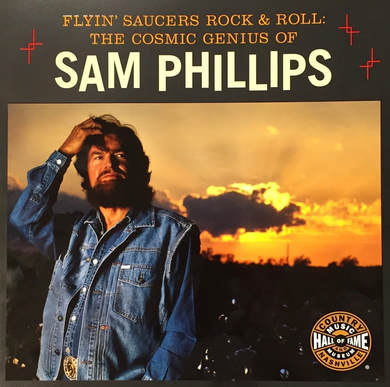
FLYIN’ SAUCERS ROCK’N’ROLL : THE COSMIC GENIUS OF SAM PHILLIPS by Peter Guralnic, Knox Phillips and others. (Backbeat.) Compiled to complement the Country Music Hall of Fame exhibition in Nashville, this book is not so much a biography of the legendary producer but rather a well-aimed introduction to the character and achievements of a man who undoubtedly had a massive influence on popular culture from the Fifties onwards. Appropriately sized the same as a 10” record, the book may only contain 66 pages but with so many well-chosen pictures (mostly full-colour) and text that really gets to the heart of the matter, I doubt that anyone would feel short-changed. Sam Phillips initially started his music career promoting, broadcasting and recording black R&B and Blues performers, not an easy task at a time when segregation was still rife throughout America. But Sam loved the music and saw his attempts to make it more popular as a way of braking down barriers. Along the way, he uncovered truly legendary talents ; an original hand-written note pictured in the book and headed with the title ‘Talent Just Waiting To Be Discovered’, goes on to list the likes of BB King, Rufus Thomas, Ike Turner and Howling Wolf ! But it would be his discovery of Elvis Presley that was to ensure his fame in the annals of history. As the story goes, Elvis entered Sam’s Sun Studios in Memphis just to record a song as a gift for his mother. After a second visit to the studio, Sam introduced Elvis to guitarist Scotty Moore and the eventual recording of ‘That’s All Right’ kick-started a musical revolution. Elvis hadn’t invented rock’n’roll but he certainly defined it. As Sam commented, he had always been looking for ‘perfect imperfection’. Not something that was done according to the rule book, but something that just sounded great ! The early Elvis recordings were soon to be followed by the likes of Jerry Lee Lewis, Carl Perkins, Johnny Cash, Roy Orbison and many others. Their influence remains vital to this day. Both the Beatles and the Stones acknowledged the legacy of Sun Studios, and who would be foolish enough not to recognize ‘perfect imperfection’ as the essence of Punk Rock ? As I said, this isn’t a thorough biography but in many ways you don’t really need to know everything about the man, you just need to know what he inspired. He may not have made the music, but he loved it and ensured that the whole world could share it. We all owe him a huge debt of gratitude.
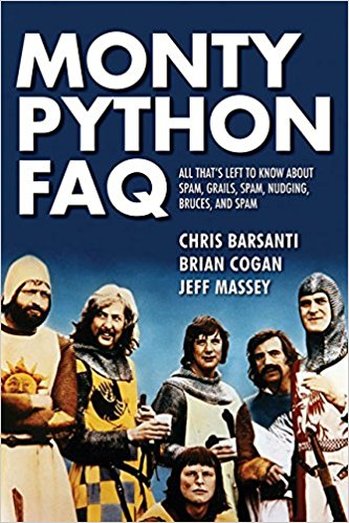
MONTY PYTHON FAQ ; All That’s Left To Know About Spam, Grails, Spam, Nudging, Bruces and Spam…by Chris Barsanti, Brian Cogan and Jeff Massey (Applause) This is very much a book for fans, by fans. Their passion for the subject is evident on every page (apart from the index, which is rather dull) but the best thing is that they keep their overview focused and avoid getting too picky or nerdish. After all, Monty Python is a subject that almost invites obsessive behaviour. From their roots in the Sixties and eventual climb to becoming bona fide comedy legends in the Seventies and beyond, with endless spin-offs and later projects that have embraced virtually every entertainment media, the Pythons have undeniably had a massive influence over modern culture. What this book sets out to do is to put it all in perspective, from the lesser-known predecessors that influenced their work (Spike Milligan in particular, but also the likes of David Frost and the Beyond The Fringe team) through to the many figures who played important parts along the way.
It also documents the private lives of the individuals, avoiding sensationalist terms, and goes on to detail their post-Python projects (nice bit of alliteration there, nudge nudge…) The chronological account of the original Flying Circus episodes does get a bit tiring at times, but only because most of us who would read this book are already familiar with most of the sketches. It works much more effectively when put to the task of detailing the individual films, which doesn’t involve so much repetition in one go. But overall, the fact that the writers are more than willing to be objective about the Pythons’ output is the real strength of the book. They’re very happy to say when something was great but also duty-bound to concede when other things didn’t work so well. Whilst there are already many books available on the subject of Monty Python, quite a few by the Pythons themselves, this one is a very successful introduction to the wider realms that their comedy bridged and a fine signpost towards their other projects and influences that really should be investigated. So please don’t ignore this review… Doug and Dinsdale wouldn’t like that…
It also documents the private lives of the individuals, avoiding sensationalist terms, and goes on to detail their post-Python projects (nice bit of alliteration there, nudge nudge…) The chronological account of the original Flying Circus episodes does get a bit tiring at times, but only because most of us who would read this book are already familiar with most of the sketches. It works much more effectively when put to the task of detailing the individual films, which doesn’t involve so much repetition in one go. But overall, the fact that the writers are more than willing to be objective about the Pythons’ output is the real strength of the book. They’re very happy to say when something was great but also duty-bound to concede when other things didn’t work so well. Whilst there are already many books available on the subject of Monty Python, quite a few by the Pythons themselves, this one is a very successful introduction to the wider realms that their comedy bridged and a fine signpost towards their other projects and influences that really should be investigated. So please don’t ignore this review… Doug and Dinsdale wouldn’t like that…
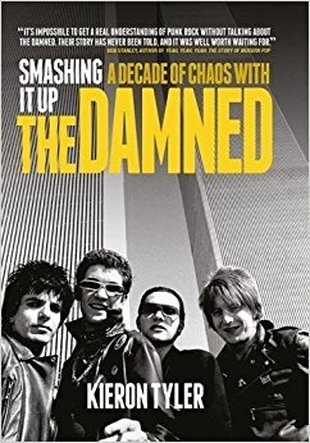
SMASHING IT UP – A Decade of Chaos with The Damned by Kieron Tyler (Omnibus) A long-overdue biography of The Damned, a subject that hasn’t been attempted since Carol Clerks’ The Light At The End of The Tunnel’ in 1987. While that book remains a rather worthy volume in itself, this manages to go into much greater detail, covering parts of the story that have only recently re-surfaced and also bringing things further up to date. Given the awkward and intricate relationships between many of the former members, Kieron has done very well. He gives the band the full recognition they deserve for their achievements in 1976-77 (even allowing ‘Music For Pleasure’ a timely and appropriate reappraisal) properly placing them shoulder-to-shoulder alongside the Clash and the Pistols in terms of cultural impact and also gives credit for the albums they produced over the next decade. The book also contains a lot of scarce or previously unseen photo’s, making it a real treat for fans. My only gripe is that so little time is spent on the period of time after 1989 (a mere twenty or so pages.) Admittedly, the various versions of the band were less than prolific during that time, but surely the albums they have produced (‘Grave Disorder’ in particular) deserved more than just passing comments ? Whatever, this is a book that finally starts to put the story straight and I’m glad that it’s here.
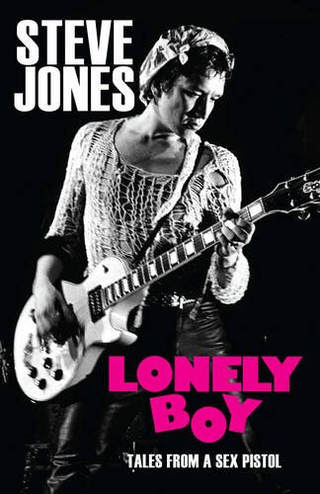
LONELY BOY by Steve Jones (William Heinnemann) Considering Jonesy’s well-known literacy problems, this is obviously co-written with an appropriate scribe (Ben Thompson) but regardless of the way it was put together, the one thing that this book captures is the subjects’ voice. If you’ve ever heard him
speak, via vintage Pistols interviews or more recently on his excellent radio show, you’ll instantly pick up this tones and mannerisms. You’ll also hear some surprisingly accurate and sometimes brutally-honest recollections. I don’t want to give too much away, but Steve had an awkward childhood that later on manifested itself in obsessive behaviour, often to his own detriment. Much of this book is about this personal aspect and the way he eventually came to terms with it, although I will make it clear that this isn’t some self-righteous ex-addict trying to tell kids what they should and shouldn’t do. He keeps it all about himself and in
this way, it wins your support much more effectively.The fact that he is willing to discuss some quite unpleasant episodes from his life also makes the whole book more believable. He really doesn’t seem to have anything to hide and no axes to grind, which gives it a balanced viewpoint that is missing in some of the other Pistols-related tomes. He has some great stories as well, which he relates with relish, but all with his sly sense of humour keeping it in touch. I have to say, unless Paul Cook surprises us all with his own memoirs, this is possibly the best book from any of the Pistols to date, although I’ll still maintain that you really need to read it alongside Matlock and Lydon’s own books to get the full picture. But this one really puts a lot of things in their place and is a lot of fun with it. Very recommended !
speak, via vintage Pistols interviews or more recently on his excellent radio show, you’ll instantly pick up this tones and mannerisms. You’ll also hear some surprisingly accurate and sometimes brutally-honest recollections. I don’t want to give too much away, but Steve had an awkward childhood that later on manifested itself in obsessive behaviour, often to his own detriment. Much of this book is about this personal aspect and the way he eventually came to terms with it, although I will make it clear that this isn’t some self-righteous ex-addict trying to tell kids what they should and shouldn’t do. He keeps it all about himself and in
this way, it wins your support much more effectively.The fact that he is willing to discuss some quite unpleasant episodes from his life also makes the whole book more believable. He really doesn’t seem to have anything to hide and no axes to grind, which gives it a balanced viewpoint that is missing in some of the other Pistols-related tomes. He has some great stories as well, which he relates with relish, but all with his sly sense of humour keeping it in touch. I have to say, unless Paul Cook surprises us all with his own memoirs, this is possibly the best book from any of the Pistols to date, although I’ll still maintain that you really need to read it alongside Matlock and Lydon’s own books to get the full picture. But this one really puts a lot of things in their place and is a lot of fun with it. Very recommended !
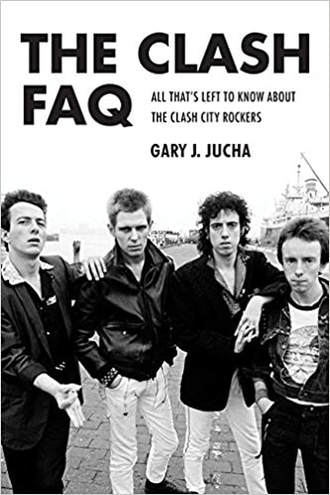
THE CLASH FAQ by Gary J.Jucha (Backbeat) This is a difficult book to review. As a biography, it’s done pretty well and some of the aspects covered are pretty insightful. For example, it stresses the importance of original drummer Terry Chimes (at both ends of the bands’ career) and is also willing to admit the actual strengths of the final line-up rather than just following the party line that it was a mistake that is best-left ignored. The author is also argues that it was in fact ‘Sandinista’ that was the bands’ masterpiece, an opinion that virtually every other fan would vehemently disagree with. Perhaps as an American fan whose love of the band grew during their later years, he has a rather different perspective to slightly-older Brit-fans, so it’s a valid point of view, even if many wouldn’t concur. He is also able to include a lot of first hand concert experiences which really bring the text to life. However, the big problem is the numerous factual errors occur, particularly when discussing contemporary bands. For example, gobbing at bands was apparently invented by Dave Vanian ! (Sensible or Scabies perhaps, but never the stylish Vanian !) while the Sex Pistols were intent on ‘cheating their fans’, a detail that could only be gleaned by someone who thought ‘The Great Rock’n’Roll Swindle’ was a ‘documentary’. Even The Clash themselves are subject to some pretty odd claims ; ‘White Riot’, for example, is said to be influenced by The Who’s ‘Baba O’Riley’ ! It’s things like this that devalue the book, which is a real shame. Perhaps a knowledgeable second-opinion in the editorial stage would have been helpful and cut down on the silly mistakes, making the more interesting content all the more potent. It certainly isn’t a bad volume and it also manages to bring a few new things to the table, but it could’ve been even better.
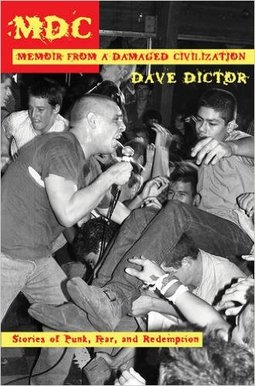
MDC : MEMOIR FROM A DESTROYED CIVILIZATION by Dave Dictor (Manic D Press) This isn’t just a biography of a hardcore band, this is the tale of someone who was, and remains, an integral part of the genres’ vitality. MDC started as ‘The Stains’ in Austin, TX in 1979, alongside such incredibly innovative bands as The Dicks and Big Boys, releasing the classic ‘John Wayne Was A Nazi’ 7” before relocating to San Francisco. After a name-change, they released their debut album, ‘Millions of Dead Cops’, in 1982, which in itself was enough to ensure their reputation. But since then, and with varying line-ups, they have continued to tour and release records, challenging preconceptions and inspiring many others. This book tells the story from Dave’s perspective, including the infamous fall-out with Bad Brains, constant touring and confrontations with various unsavoury characters (from skinheads and the police through to the Pope !) The stories are written in short chapters that maintain an interesting and entertaining tone, illustrating how things really were for a ground-breaking band, particularly during the 1980’s. The fact that Dave is still fronting MDC as they continue to tour and release new music only goes to strengthen the validity of this book. Track-down a copy as soon as you can !
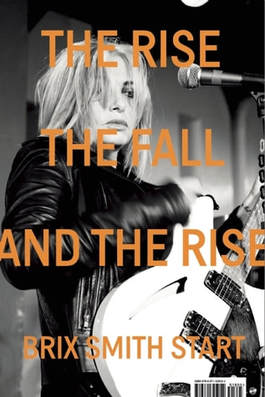
THE RISE THE FALL AND THE RISE by Brix Smith-Start (Faber & Faber) In short, this is a book by Brix about Brix. It is not a book about The Fall, although they do figure largely in it. There is a lot about her peculiar childhood, parental relationships and her life since her last tour-of-duty in the band came to an end. She’s been a busy girl and there’s a lot to talk about. Besides Mark E. you’ll also find Gary Lineker, Nigel Kennedy and, of course, her current husband, Phillip. It’s an intriguing story and although there are a few factual errors, it doesn’t really matter as it’s the gist of the tale that counts. She’s had her high points along with the low, but she’s always found a way forward, changing course just as often as staying true to an original direction. Some of the revelations will be surprising, others will come as expected, but she tells it with a good degree of openness and candour. It probably won’t change your mind about her (or Mark E. for that matter) but it does allow you to understand things a bit more than you probably did before. Definitely worth your perusal.
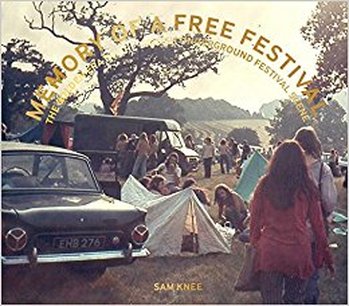
MEMORY OF A FREE FESTIVAL BY Sam Knee (Cicada Books) I wasn’t sure what to expect from this book as most festivals have, in recent years, become just as turgid and commercialized as the rest of the music business. But this book is a celebration of the true underground spirit that originally established the Festival scene in the UK, starting in the late Fifties during the bohemian / beatnik era and remaining
until the mid-Eighties, when Thatchers’ vicious pig cronies put an end to free festivals. Admittedly, some of the larger commercial festivals did continue to promote interesting line-ups for a while after this and it can be claimed with some validity that the early rave scene continued the spirit, but to date, the true Golden Era was those three decades. Now, I have to admit that I’ve never really been a fan of festivals. I don’t particularly enjoy camping and my attention-span runs out early when too many bands are involved. But I can appreciate that the Free Festival scene did try to present a real alternative which was much needed as a contrast to the UK’s traditional stuffiness. Festivals such as Phun City, Stonehenge and Windsor were probably the best manifestation of this, although many others arose in their wake. Glastonbury also played its’ part, although Michael Eavis was always keen on making money from the event (the free festivals at Glastonbury were helmed by Andrew Kerr in the Seventies.) What this book captures alongside the details, is the attitude of the movement, before big companies and other money grabbers changed the whole thing into little more than a cynical cash-making exercise. If you look carefully, you can still find the original spirit still alive and dancing (check out the ‘Trespass’ events) as long as you don’t fall for the hype. Containing extensive photo’s (which tend to concentrate on the audiences rather than the performers) this book is a beautifully-presented and vital insight to a scene that is mostly misrepresented these days but which can still impress and inspire. Don’t let the bastards sell your culture to you, take back what was yours in the first place !
until the mid-Eighties, when Thatchers’ vicious pig cronies put an end to free festivals. Admittedly, some of the larger commercial festivals did continue to promote interesting line-ups for a while after this and it can be claimed with some validity that the early rave scene continued the spirit, but to date, the true Golden Era was those three decades. Now, I have to admit that I’ve never really been a fan of festivals. I don’t particularly enjoy camping and my attention-span runs out early when too many bands are involved. But I can appreciate that the Free Festival scene did try to present a real alternative which was much needed as a contrast to the UK’s traditional stuffiness. Festivals such as Phun City, Stonehenge and Windsor were probably the best manifestation of this, although many others arose in their wake. Glastonbury also played its’ part, although Michael Eavis was always keen on making money from the event (the free festivals at Glastonbury were helmed by Andrew Kerr in the Seventies.) What this book captures alongside the details, is the attitude of the movement, before big companies and other money grabbers changed the whole thing into little more than a cynical cash-making exercise. If you look carefully, you can still find the original spirit still alive and dancing (check out the ‘Trespass’ events) as long as you don’t fall for the hype. Containing extensive photo’s (which tend to concentrate on the audiences rather than the performers) this book is a beautifully-presented and vital insight to a scene that is mostly misrepresented these days but which can still impress and inspire. Don’t let the bastards sell your culture to you, take back what was yours in the first place !
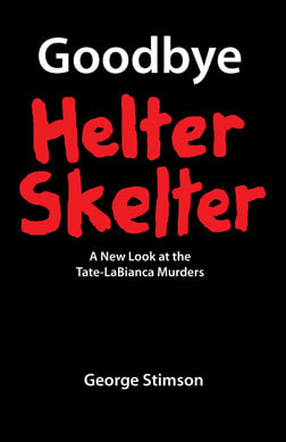
GOODBYE HELTER SKELTER by George Stimson (Peasenhall Press). So much has been written and broadcast about Charles Manson and his alleged ‘family’ but few have bothered to look beyond the sensationalism to question whether the generally accepted ‘facts’ actually hold much water in the real world. Manson was declared guilty by the media long before the final verdict and no-one wanted to ruin the big story. But so many of the ‘details’ which are readily accepted are either misleading, unsubstantiated or just plain false. The main point of contention is the extent of Manson’s actual complicity in the crimes. The prosecution had to convince everyone that he was the evil mastermind behind the killings, intent on his bizarre plan to rule the world. On the other hand, all those involved originally offered the alternate motive that the murders were committed as copycats killings in an attempt to save their friend, Bobby Beausoleil, from jail. (Most have since refuted this version in attempts to gain parole.) This version is still strongly supported by the facts, but accepting this would have made Manson’s role much less integral to the plot, something that the prosecution and media were already unwilling to accept. The trial itself denied Manson his Statutory Right to conduct his own defence and the Prosecution also gave Linda Kasabian a pardon in exchange for her supporting evidence, despite her own involvement in the crimes. At the end of the day, the trial was stage like a Hollywood production. What this book sets out to do is separate the facts from the myths. Built around hours of conversations with Manson himself (both with the author and from the extensive Sandra Goode archives) it presents a well-reasoned examination of the events as opposed to the screenplay-version that is usually related. Stimson doesn’t try to deny or excuse what happened and he doesn’t try to excuse Manson for his more outlandish views or actions, but at the root of the book is the intention to tell the story as accurately as possible and to present the likeliest scenario for what really happened. It doesn’t try to make out that Manson was entirely innocent and, indeed, he has never denied his knowledge and involvement in the crimes. But it does try to ascertain what really took place and what was, basically, made-up by individuals who had a vested interest in creating the ‘monster’ that Manson represents to most people. As such, this is probably the most well-balanced book you’ll ever read about the case and in an era where more and more people are beginning to realize that what the media reports isn’t necessarily the truth, perhaps this is as good a time as any to make your own reassessment.
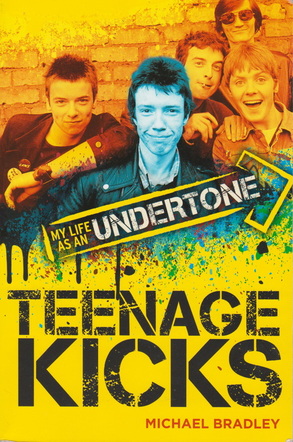
TEENAGE KICKS by Michael Bradley (Omnibus.) Alongside Andrew Matheson’s ‘Sick On You’, this is one of the most entertaining music biographies that I’ve ever read. Mickey Bradley has a great style of writing that really captures the spirit of the band and their music. Telling the tale of the Undertones from his own perspective, he manages to cover the highs and lows of their original career, from childhood through to the end of the band in 1983. It’s great fun and totally unpretentious, with no delusions about their naivety and peculiarities, although, of course, it was those quirks that were such an important characteristic of the band. They wrote awesome songs, but you never though they were anything other than a bunch of mates having a good time. In some ways perhaps that worked against them, especially as their music developed, but the band themselves could only ever be themselves. The stories about growing up in Derry during the Seventies are also intriguing, giving a down-to-earth impression of what life was like there at the time, without lingering on the Troubles. Some may be surprised that there is no negativity towards Feargal and, in fact, the camaraderie between all members of the band is something that really stands out. I would, perhaps, have liked a further chapter about the eventual reunion of the band, but at the same time, the book covers the story of the original five members so succinctly, maybe that would have been a distraction. Either way, this is a great account of a deservedly respected band and I’m sure it will be fun whether you’re a fan or not. But you really should be…
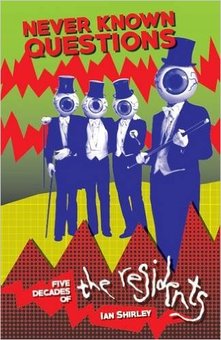
NEVER KNOWN QUESTIONS – Five Decades of The Residents, by Ian Shirley (Cherry Red Books) Ian Shirley originally wrote a book about The Residents (‘Meet The Residents’) in 1994. This volume is not merely an updated version but a completely re-written volume, including new and updated material as well as brand new interviews. Much like The Residents themselves, Ian Shirley took his original work and ‘RMX’ed it to provide a more valid, contemporary statement. Alongside the recent ‘Theory of Obscurity’ documentary, this is probably as definitive an article you will ever find about a band whose very nature is to be undefinable. It provides you with as many facts as you’ll ever need to know about the Eyeballed-Ones and doesn’t concern itself with identities or individual characters. It’s the work that counts, not the private lives, and whilst there are many collaborators and allies who are able to elaborate on the ideas and concepts, the band themselves are happy enough to present their work and let the audience arrive at their own conclusions. Ian Shirley clearly understands this and presents the details in an appropriate, complimentary way. I’m sure there will be further books about The Residents, but I very much doubt that any will ever reach a better understanding of the subject than this.
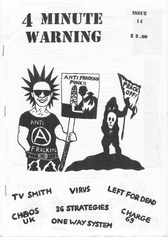
4 MINUTE WARNING #14 (£2.00 + SAE from Mitch Elsden, 31 Fir Grove, Marton, Blackpool, FY1 6PJ.) One of my favourite current fanzines, more because of the total enthusiasm you’ll find on every page than anything else (and there’s plenty of decent bands and articles covered as well.) It’s unashamedly DIY punk rock, but that’s what makes it fun and interesting. No excuses, it just gets on with what it wants to be doing. Lots of interviews (including TV Smith, 36 Strategies, Chaos UK and One Way System, amongst others) loads of reviews and other articles. You don’t have to like or agree with everything, but you’ll want to read it anyway. Two measly quid for 46 A4 pages, it’s a bargain, I tell ya !
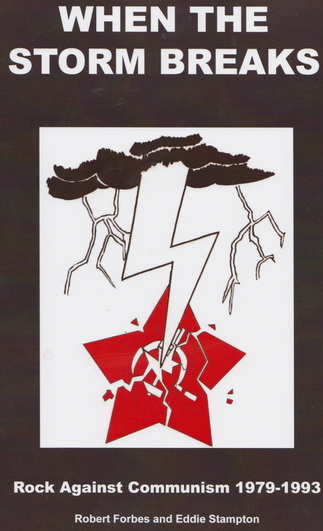
WHEN THE STORM BREAKS by Robert Forbes & Eddie Stampton (self-published.) I know there are people out there who would prefer that this book didn’t exist at all, and would prefer that I hadn’t read it, let alone reviewed it. But, as the saying goes, Knowledge is Power. If I am to form an opinion on the likes of Skrewdriver, Blood & Honour and Rock Against Communism, I need to know the facts. So many stories and so much propaganda has been spread by both sides that it becomes difficult to know what is true and what is false. This book sets out to put things in a factual light and, indeed, the references are meticulously listed throughout. There are those who would argue that such a book shouldn’t be allowed to exist as some of the opinions expressed within (through the extensive interviews) could influence the readers to form extremist views, but let’s face it - the kinda people who form racist views are just as likely to be influenced by The Sun or The Daily Mail. So at which point would the book-burning begin ? No, I would prefer to be given the choice to read books like this and given the credit that I’m intelligent enough to form my own opinion. If you face this book with an objective approach, it certainly gives you the option. To blindly condemn it just because you don’t like the subject is certainly not the best way to confront it.
To begin with, although Eddie Stampton is involved with the Nationalist movement, Robert Forbes writes from a neutral position, intrigued by the subject but not involved in the dogma. This gives the writing a more-balanced approach than had it been written by either a supporter or someone on the opposing side. That being said, this is still something that most people would find abhorrent, and the propensity towards violence is particularly repellent. But once you read the book, you begin to realise that it’s something that has become an ogre far out of proportion to the reality. This is probably the first time that the story of Skrewdriver and their ilk has been set-out entirely factually, including the dates, the details and the people involved. The first thing you’ll notice is that there actually weren’t that many people in the ‘movement’ (in the UK, at least) and that the few times they did come to any kind of national attention (such as the Waterloo and Jubilee Gardens incidents) the numbers always seemed greater due to the anti-fascists and bystanders, making it much more of a spectacle but not accurately accounting for the amount of nationalists actually involved. The second thing is that, throughout the book (which covers a 15 year period) there are continuous tales of squabbling and in-fighting. It certainly doesn’t give the impression that there was a solid, common purpose, even within the relatively small numbers involved.
The other side of this story is, of course, the music itself. The book attempts to give a fair assessment of this and certainly doesn’t shy away from saying when a band were mediocre or, indeed, just plain bad (even some of the better known bands get called-out at times.) It’s also interesting that, although the Oi movement was blamed by many for promoting racist or neo-nazi views, most of the bands quickly moved away from that style towards more traditional Rock music – even ballads became an acceptable part of the albums !
Now, I’m not going to say that everything said in the book is bad, and in fact, a few people even talk some sense. Being patriotic, for example, is not necessarily the same as being racist or xenophobic, and taking pride in European culture does not mean that you have to deny everything else. But the problem is that such extreme views, as held by some in this book, end up making the chance of a proper debate on subjects such as immigration far more difficult. The liberal media automatically take the opposing viewpoint, making it a ‘for or against’ topic, and frankly, it really isn’t that simple.
But the real issue that comes across is that very few of the interviewees seem to hold clear, coherent beliefs apart from the option of blaming someone else. Skrewdriver may have sung ‘White Power for England, before it is too late’, but as Stewart Home has previously pointed out, England has always had, and no doubt will continue to have, a white-based ruling-class. Such posturing is completely ignoring the British hierarchy which will always be the root-cause of the problems faced by the common people in this country, regardless of how long they’ve lived here.
There are other themes that could be addressed (such as the obsession with Viking and male-warrior imagery, particularly poignant in the case of Nicky Crane, for example…) but really, where this book succeeds is that it puts all the facts together and, whether you support these beliefs or oppose them, you now have the opportunity to know what it was about and why it happened. You don’t have to be a Nazi to read this book, and you can make your own mind up at the end of it. Isn’t that what democracy is about ?
(PS - although the initial run of this book has already sold-out, a revised version is planned for publication by Feral House (USA) before the end of 2015…)
To begin with, although Eddie Stampton is involved with the Nationalist movement, Robert Forbes writes from a neutral position, intrigued by the subject but not involved in the dogma. This gives the writing a more-balanced approach than had it been written by either a supporter or someone on the opposing side. That being said, this is still something that most people would find abhorrent, and the propensity towards violence is particularly repellent. But once you read the book, you begin to realise that it’s something that has become an ogre far out of proportion to the reality. This is probably the first time that the story of Skrewdriver and their ilk has been set-out entirely factually, including the dates, the details and the people involved. The first thing you’ll notice is that there actually weren’t that many people in the ‘movement’ (in the UK, at least) and that the few times they did come to any kind of national attention (such as the Waterloo and Jubilee Gardens incidents) the numbers always seemed greater due to the anti-fascists and bystanders, making it much more of a spectacle but not accurately accounting for the amount of nationalists actually involved. The second thing is that, throughout the book (which covers a 15 year period) there are continuous tales of squabbling and in-fighting. It certainly doesn’t give the impression that there was a solid, common purpose, even within the relatively small numbers involved.
The other side of this story is, of course, the music itself. The book attempts to give a fair assessment of this and certainly doesn’t shy away from saying when a band were mediocre or, indeed, just plain bad (even some of the better known bands get called-out at times.) It’s also interesting that, although the Oi movement was blamed by many for promoting racist or neo-nazi views, most of the bands quickly moved away from that style towards more traditional Rock music – even ballads became an acceptable part of the albums !
Now, I’m not going to say that everything said in the book is bad, and in fact, a few people even talk some sense. Being patriotic, for example, is not necessarily the same as being racist or xenophobic, and taking pride in European culture does not mean that you have to deny everything else. But the problem is that such extreme views, as held by some in this book, end up making the chance of a proper debate on subjects such as immigration far more difficult. The liberal media automatically take the opposing viewpoint, making it a ‘for or against’ topic, and frankly, it really isn’t that simple.
But the real issue that comes across is that very few of the interviewees seem to hold clear, coherent beliefs apart from the option of blaming someone else. Skrewdriver may have sung ‘White Power for England, before it is too late’, but as Stewart Home has previously pointed out, England has always had, and no doubt will continue to have, a white-based ruling-class. Such posturing is completely ignoring the British hierarchy which will always be the root-cause of the problems faced by the common people in this country, regardless of how long they’ve lived here.
There are other themes that could be addressed (such as the obsession with Viking and male-warrior imagery, particularly poignant in the case of Nicky Crane, for example…) but really, where this book succeeds is that it puts all the facts together and, whether you support these beliefs or oppose them, you now have the opportunity to know what it was about and why it happened. You don’t have to be a Nazi to read this book, and you can make your own mind up at the end of it. Isn’t that what democracy is about ?
(PS - although the initial run of this book has already sold-out, a revised version is planned for publication by Feral House (USA) before the end of 2015…)
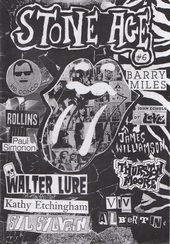
STONEAGE fanzine #6. ([email protected]) Stoneage has acquired a near mythical status, in that I’ve known Willy for a few years but, although several reliable witnesses have claimed sightings, I had never actually seen any physical evidence of the alleged fanzine. But that has now all changed and I am no longer a sceptic. The truth is out there, and a damn fine read it is, too. Loads of generally short interviews, often concerning encounters with the Rolling Stones, with the likes of Walter Lure, Henry Rollins, Viv Albertine, Kid Congo, Sylvain Sylvain and Paul Simenon, plus more substantial interviews with James Williamson and Thurston Moore. The great thing is Willy’s easy-going style, more intent on swapping stories about favourite records and gigs than getting into meaningful lyrics of guitar specifications. It’s a lot of fun, the sorta fanzine you’ll read all the way to the back page. Trust me, this is a good one – get in touch as soon as possible.
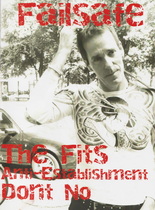
FAILSAFE fanzine #12 ([email protected]) Probably my favourite UK fanzine, this issue contains in depth interviews with The Fits, Anti-Establishment and veteran US band Don’t No, as well as all the usual, extensive reviews. What I like about it is that the interview subjects are chosen because they’re going to be interesting, rather than just a ‘big name’. Even if you’ve never heard of the band, the interview will be a great read because of the depth and detail it goes into. But it’s not just a trainspotting exercise, there’s plenty of humour and purpose behind it all. This is one of the few fanzines I will read from cover to cover and I can’t recommend it enough.
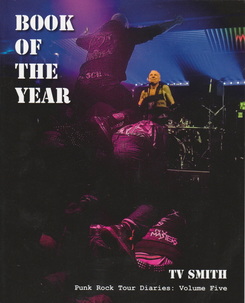
BOOK OF THE YEAR by TV Smith (Arima) Exactly what it says in the title – a document of every gig played by TV Smith (and a few days-off) during 2013. When you realise that amounts to over 120 performances and nearly 20 different countries, as far apart as Russia and Uruguay, then you’ll see that it involves a lot of experiences and a lot of entertaining material. TV writes in a very down-to-earth style, almost as if he’s just chatting on a one-to-one basis, so it’s very easy to be drawn into his world. It’s certainly not a life of luxury and he never holds any such pretentions. This is simply the story of an artist with a desire to take his music wherever he can. This is what he does. Fortunately, enough people appreciate his work and support his efforts. While it doesn’t always go according to plan, it’s great to see that he always comes out on the other side. It’s all about being true to yourself and not being sold-short and the book really captures the spirit of it all. Entertaining and inspiring, this should not be missed.

CLOTHES CLOTHES CLOTHES MUSIC MUSIC MUSIC BOYS BOYS BOYS by Viv Albertine (Faber & Faber) Having never been a huge fan of The Slits, I wasn’t even vaguely sure what to expect from this autobiography, but I’m pleased to say it’s surprisingly good and I think you would enjoy it even if you have no liking or knowledge of the music. Viv writes and tells her story in a very down to earth style but always remains intelligent, articulate and very perceptive. Admittedly, it may be easier to understand events in retrospect, but Viv does this without any pretensions or revisionism, which so often occurs in memoirs. Instead, she just sticks to the events and characters, describing how they went on to affect her emotionally or creatively. Whilst The Slits are now, quite rightly, considered feminist icons, and many of the people they were closely involved with have also reached similar cultural status, Viv is just as intent on focusing on her own frailties as much as her successes. In fact, one of the more interesting aspects of the book is how she dealt with her life post-Slits, returning to a more routine lifestyle and, again, she opens up as much about the low points as the high, which makes it much easier to relate to her as a real person. It’s an inspiring book and it leaves you with a sense of honesty and integrity. The tale of a normal person in an extraordinary life, perhaps ?

ANGER IS AN ENERGY by John Lydon (Simon & Schuster) Considering John Lydon’s current status as an alternative national treasure, and the fact that his first autobiography only dealt as far as his time in the Pistols, he’s well within his rights to release a second volume. He has had plenty of time and exploits since then, although that being said, the first 180 pages does cover much of the same ground again (albeit with plenty of new details.) But it’s from that point onwards that things start to get really interesting. He puts forward a pretty realistic theory concerning the Sid & Nancy deaths and then moves on to the development of PIL. The thing is, it was the chemistry between the original band members that created the volatile atmosphere necessary for them to produce the remarkable music they made together, but it also left them vulnerable to instability and, inevitably, their demise. Lydon’s claims that he was innocent in all of this don’t really ring true, as his creativity obviously fed from the same factors and that would indicate he must have been a part of the whole situation. There’s always going to be different points of view, but as this is Lydons’ book so we only get his. He also goes into detail about later and current PIL line-ups, plus the Sex Pistols reunions, which now seem to be at an end. There’s also a lot more information about his life with Nora and his various escapades away from music. At times, his memory does seem to be a little selective but overall it’s a fascinating read and, when you consider that this is a man who has had a huge social and cultural impact over the past few decades, you can only respect him and his opinions, even if you choose to disagree.
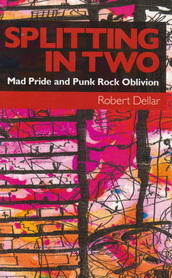
SPLITTING IN TWO by Robert Dellar (Unkant) Biographical work documenting Roberts’ exploits in the fields of Punk Rock, squatting and Mental Health Care. In particular, he goes into some depth concerning his involvement with the radical pressure group, Mad Pride, a group who continue to be as much about entertaining themselves as having their points heard. It’s interesting to hear the story from someone so closely involved, as it really explains their motives and describes the characters who made it so unique. It’s also of particular interest to me, and I’m sure this will be the same for many others, as so many of the events and places discussed cross over into my own timeline, allowing me to directly relate to many of the tales, even though I know little about the author himself. His life has many twists and turns, yet more to relate to, and it’s mostly written in a pretty easy-going narrative, although occasional lapses into a Stewart Home / Richard Allen style provide amusing breaks from the regular text. As a document of a life spent in an alternative environment, this is probably as real as it gets.
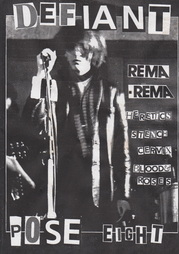
DEFIANT POSE fanzine #8 (PO Box 2544, London, NW6 3DF) I can’t believe I haven’t come across this before now, as it’s just the sort of fanzine that I really enjoy. This issue came to my attention due to the inclusion of a 7” featuring previously unreleased tracks from Rema Rema (see vinyl review elsewhere) but the fanzine itself is an excellent read. Like Failsafe, it concentrates more on lesser-known but highly-interesting bands whose stories deserve to be documented. A Rema Rema interview / retrospective features prominently, as well as the likes of Blood & Roses, Cervix, Heretics and The Stench (arguably the first all-female punk band, having performed even before The Slits !) An anarcho-situationist attitude is prevalent and makes for a great presentation. You really need to catch up on this publication as soon as you can.
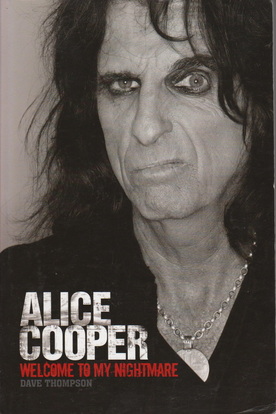
ALICE COOPER – WELCOME TO MY NIGHTMARE by Dave Thompson (Omnibus) Whilst Michael Bruce and Alice himself have both published biographies, they’ve obviously been from a subjective viewpoint and not really got under the skin of the Alice Cooper phenomenon. This is the first book that attempts to do so and, to a great extent, it’s pretty successful. It’s the details concerning the original band that are most fascinating. As a band, opposed to the solo artist that the singer became, they really were quite remarkable, able to stir up controversy but always providing great music to justify the publicity. The deserved success of ‘Welcome To My Nightmare’ may have prompted the continuation of Alice Cooper as a solo performer, but sadly, none of his albums since that time matches the classics recorded by the original band, even though live shows have remained consistently entertaining. Rather than a biased press release, that’s what this book really illustrates and as such it’s a fascinating read. Unfortunately, nowadays Alice Cooper is thought of as the born-again Christian golf fanatic who plays alongside members Guns & Roses or Johnny Depp, but there was a time when the band, as a whole, were considered a threat to society whilst creating some of the best, most inventive rock music of the era. Trust me, you need to know about that band.
